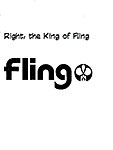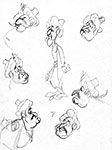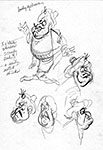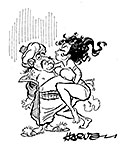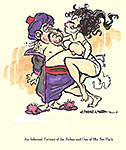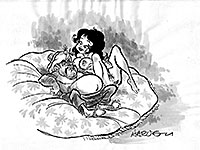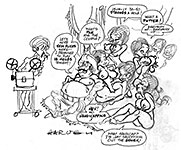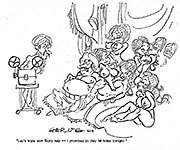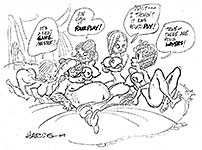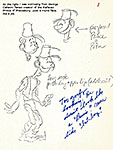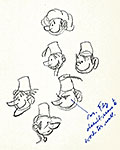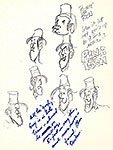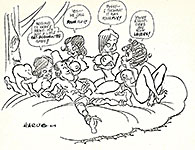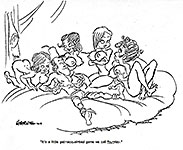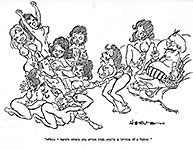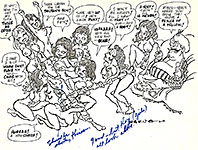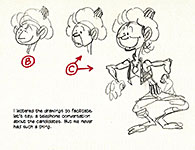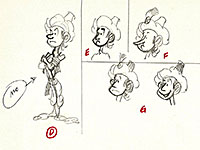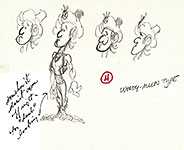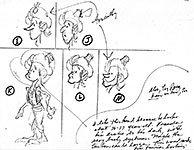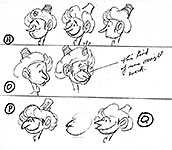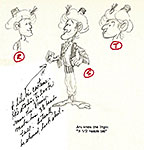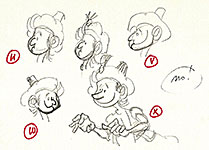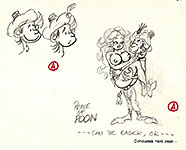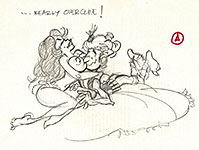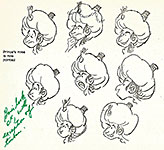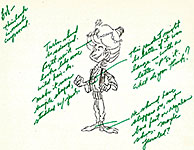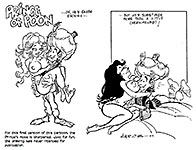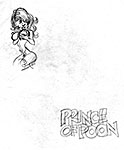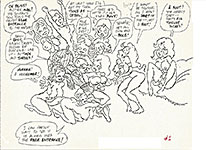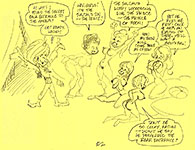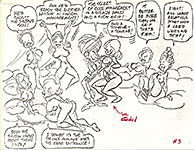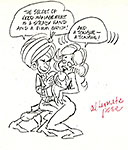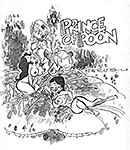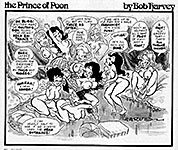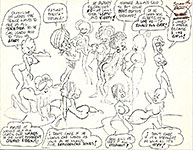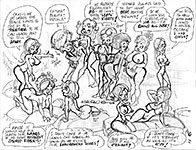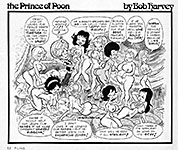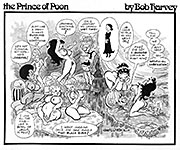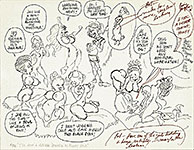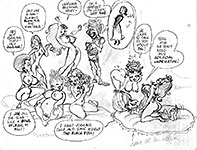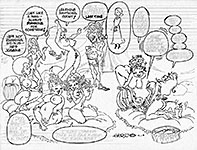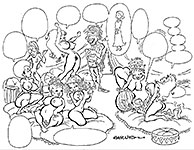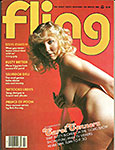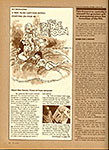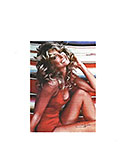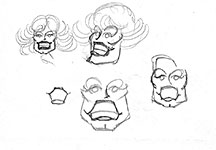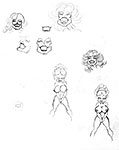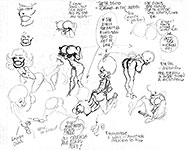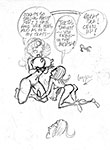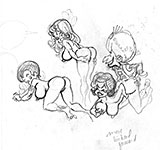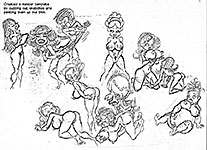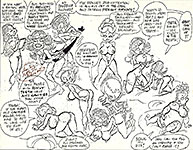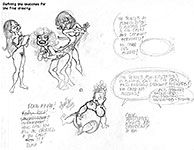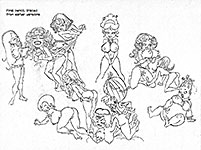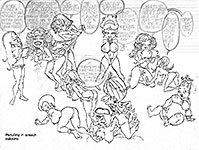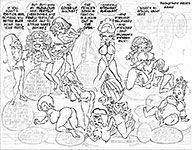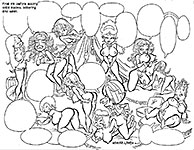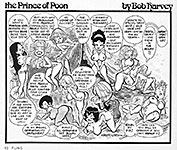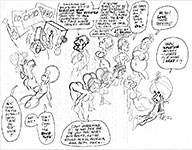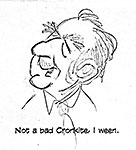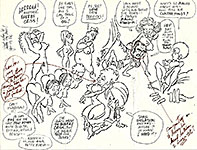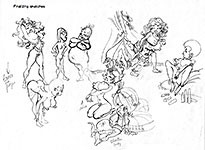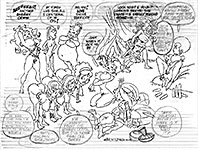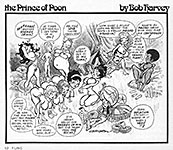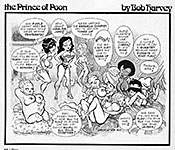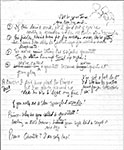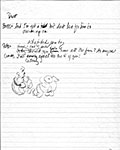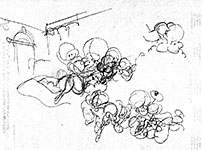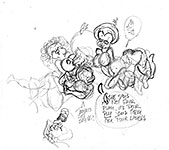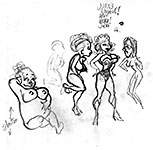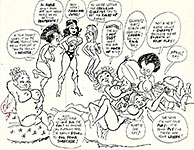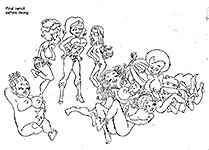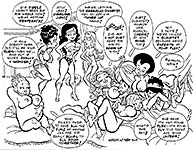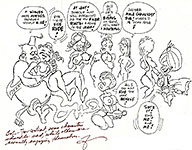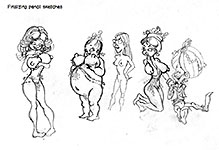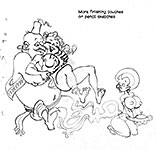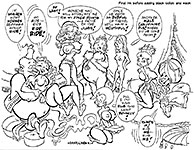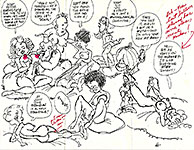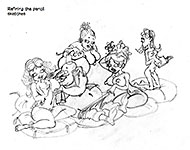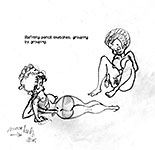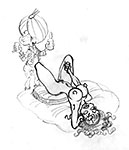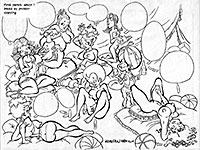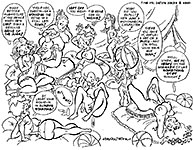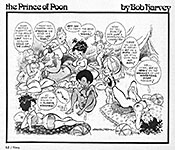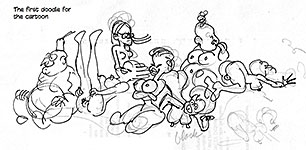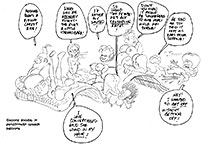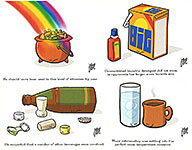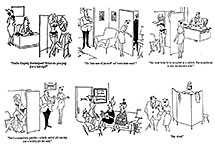 |
|||||||||||||||||||||||||||||||||||||||||||||||||||||||||||||||||||||||||||||||||||||||||||||||||||||||||||
Opus 350 (April 1, 2016—no foolin’). Old men spend an inordinate amount of time gazing fondly upon their pasts. It is easy to account for this quirk: the past is where they’ve lived most of their lives, so there’s a lot there to contemplate. And I’m no different than any other old man. And so to commemorate our 350th posting of Rants & Raves, we offer “A Fling for 350,” a profusely illustrated history of Harv’s eroticartoon for the girlie magazine Fling in the late 1970s—including correspondence with the editor, sketches and pencil roughs as well as the final published cartoons. We also recognized Pat Oliphant’s “retirement” and air Playboy’s lame explanation for giving up on cartoons. We also note the guest artists on Dilbert and celebrate the 65th anniversary of Dennis the Menace (in both countries) (check it out for an explanation for that!). And—in honor of politics’ gift to editorial cartoonists—we have a yuge segment on Trumpery, plus the usual review of the month’s editoons, a review of Murphy Anderson’s Buck Rogers, and an obit for Larry Katzman. And more, much more. Here’s what’s here, by department, in order—:
NOUS R US Oliphant Has Left the Room Ted Rall Sues Los Angeles Times Obama Prefaces Peanuts Superman Bombs—Again Playboy Explains The 10 Most Expensive Comic Books Ever Sold Lois and Clark Endure
Odds & Addenda Playboy for Sale? Manga Museum in Japan Al Jaffee’s World Record
FUNNYBOOK FAN FARE Marvel’s Civil War Dr. Strange Movie A-makin’ Frank Miller’s Dark Knight III, Nos. 2 & 3 Women in Comics—As Characters and As Creators
EDITOONERY Trumpery Dump Trump Name Calling SCOTUS Nomination? Trump Caricatures Fearsome Megyn Kelly Campaigning and Sampling the Month’s Editoons Caricatures by Ann Telnaes Last Minute Arrivals
THE FROTH ESTATE And the Creation of the Trumpet
NEWSPAPER COMICS PAGE VIGIL On the Pages of the Nation’s Funnies Guest Artists on Dilbert
Dennis the Menace’s 65th Anniversary
A FLING FOR 350 Celebrating Rants & Raves’ 350th Posting Originating and Perpetrating An Eroticomic And—Jeremy Lambros’ Domestic Abuse
BOOK REVIEW Murphy Anderson’s Buck Rogers Reprinted
PASSIN’ THROUGH Larry Katzman
QUOTE OF THE MONTH If Not of A Lifetime “Goddamn it, you’ve got to be kind.”—Kurt Vonnegut
Our Motto: It takes all kinds. Live and let live. Wear glasses if you need ’em. But it’s hard to live by this axiom in the Age of Tea Baggers, so we’ve added another motto:.
Seven days without comics makes one weak. (You can’t have too many mottos.)
And our customary reminder: don’t forget to activate the “Bathroom Button” by clicking on “print friendly version” so you can print off a copy of just this installment for reading later, at your leisure while enthroned. Without further adieu, then, here we go—:
NOUS R US Some of All the News That Gives Us Fits
OLIPHANT HAS LEFT THE ROOM Long revered among his fellow editorial cartoonists as the best of the breed, Pat Oliphant has retired. Well, not retired exactly. As he told editoonist Matt Wuerker, he hadn’t retired—he’d quit. “After 60 years,” Oliphant expostulated, “I’m sick of these people.” The last cartoon posted at his website is dated January 13, 2015. That marks the date of his quitting. “Damn,” said editoonist Steve Benson at the Arizona Republic. “I remember when we had Pat in our midst at a convention of the Association of American Editorial Cartoonists in Salt Lake City. It was like we were in a sacred temple, caught up in reverential awe. You could have heard an ink bottle drop.” Said cartoonist Ted Rall, another of Oliphant’s inky-fingered admirers: “I like how he just stopped. No pretentious announcement, which, given his status, would have garnered tons of ego-boosting coverage—and would have inadvertently hurt us because of the inevitable ‘all the greats are gone now’ inferences.” Oliphant’s departure was, Rall observed, “a classy, characteristically grouchy, exit. Nice.” Oliphant’s is a class act any way you look at it. His cartoons are usually hysterically funny as well as caustically critical. You can’t ask more of an editorial cartoon. But sometimes we got more—: In the catalogue published to accompany a 2008 exhibition of his work, Leadership: Oliphant Cartoons & Sculpture from the Bush Years, Oliphant recalled Gerald Ford and a 1996 gathering of Republicans for whom the cartoonist provided (as he said) “the amusement.” “Because of his perceived penchant, quite undeserved, for banging his head on helicopters and falling down stairs, I habitually depicted President Ford wearing a large band-aid across his forehead. [The group] was reassuringly relaxed, and I was encouraged to draw and remark on people and incidents of the Nixon-Ford years, working in charcoal on paper under a tv camera while the image was projected on a huge screen behind me as I drew. “With this setup in place, I caricatured, with varying degrees of politeness, such luminaries as Nixon, Kissinger, Schlesinger, Rumsfeld, Cheney and so on, and eventually (wait for it) Gerald himself, complete with band-aid. The president joined in the reaction with great roars of laughter, and at that I quickly finished my presentation, relieved that it was over. “Some say you should not encourage cartoonists too much as they are given to overreacting to applause, which may be the explanation for what I did next, but whatever the case, I have a set of Kennerly photos to prove it. “Leaving the podium,” Oliphant went on, “I crossed the room to President Ford and with the charcoal drew a large band-aid on his forehead. The photos show me in the act while the president stands perfectly still, his eyes rolled upward, wearing a huge, expectant smile. A Secret Service agent appeared at my shoulder just then and muttered, ‘You do that one more time, and you’ll never cartoon in this town again...’ I was glad to note he was grinning when he said that.” Next
to this disquisition, Oliphant published the picture of Ford I’ve posted
nearby—his head thrown back, roaring with laughter. “So I offer this drawing of President Ford,” Oliphant concludes, “sans band-aid, as a farewell gesture of respect. He was a gentleman of generous good humor and one heck of a good sport. I have drawn many presidents, but he is the only one I ever drew ON.” At
that Salt Lake City AAEC convention referred to above, Oliphant was a guest
speaker, which role he filled by talking and sketching as he talked, the images
of his drawings projected on a screen behind him. He was asked what his
all-time favorite cartoon was (impossible to answer, of course), and he drew a
quick sketchy version of the one you see hereabouts, “the annual running of the
altar boys.” It is a perfect Oliphant cartoon. It’s funny—the expressions of delightful anticipation on the clerical faces, the terror on the faces of the altar boys, the quantity of the pursuers and the pursued, their exaggerated number vaulting the picture into the realm of towering absurdity. And the absurdity conveys Oliphant’s outrage at the abuse: the very idea that such practices in the Church could inspire a monumentally disrespectful cartoon like this is high comedy in itself. And it’s a perfect Oliphant cartoon because there’s so much drawing in it. “I love drawing,” Oliphant told Les Daly in The Atlantic in a 2014 interview, “—and maybe I get lost in it sometimes. I enjoy it so much that I just keep drawing and drawing, and as the drawing develops, you see other chances and places you can take it. When you get into some cartoons like that, you can see this is going to be a long day, but what the hell? “I’m a captive of my own idiocy sometimes” Oliphant continued. “The more people I put in, the happier I am. Except when I’m in a hurry, and then my enthusiasm runs up against the deadline. You have to keep up your enthusiasm. It mustn’t show in the cartoon that you’re in a hurry. [But] it adds to the spontaneity if you’re working fast.” Of the last two cartoons posted at his website, one has a mob of people. But no comedy infuses the scene. And little Punk, the smart aleck penguin with a punchline who usually comments on the larger picture from the safety of the margin, isn’t present in either cartoon. Oliphant left Punk out whenever his cartoon dealt with tragedy. The first of the last two cartoons was posted on January 8, the day after the murders of Charlie Hebdo cartoonists and writers in Paris. Oliphant depicts the two humorless murderers.
In Oliphant’s last cartoon, cartoonists are fighting for Liberty. There.
Now I’ve gone and done it. I’ve created a fuss about his
And what is Oliphant going to be doing with his freshly created spare time? He offered Daly a preview: “I’ve been drawing editorial cartoons for 60 years, 50 years in this country. I don’t intend to die doing this. I like drawing, but I have a lot of other things that I haven’t done as much of as I want to—sculpting, lithography, monotypes. Things that I also enjoy doing, without having to hit a deadline.
RALL SUES LOS ANGELES TIMES Cartoonist and author Ted Rall, who was fired by the Los Angeles Times last summer in a highly questionable manner (see Opus 342a), has brought suit against the paper for reckless and malicious defamation, blacklisting, violation of labor code (Sect. 1102.5), wrongful termination of employment in violation of public policy, breach of implied-in-fact contract not to terminate without good cause, and intentional infliction of emotional distress. Filing the suit on March 14, Rall seeks economic and non-economic compensatory and punitive damages in an unspecified amount—and a jury trial. A press release from Rall’s lawyer, Shegerian & Associates in Santa Monica, California, notes that “Rall was hired by the Times as an editorial cartoonist in 2009 and published approximately 300 of his cartoons and more than 60 of his blog posts between 2009 and 2015. At no time during his employment was Rall disciplined or written-up and he was consistently praised for his work.” He was fired last summer because the Los Angeles Police Department objected to his blog’s characterization of a encounter with a cop, who arrested him for alleged jaywalking. The LAPD said Rall’s account of the event was false, and the Times fired him because of the alleged inaccuracy. Then the Times announced at its website that it was firing Rall and explained that his veracity was questionable. Rall, however, was able to demonstrate the accuracy of his account by obtaining a tape recording of the arrest, which supported his side of the disputation. Despite this exonerating evidence, the Times published yet another article further defaming Rall. All of the incidents embraced by this situation are reconstructed at Opus 342a in tedious detail. Shegerian & Associates founder Carney Shegerian describes the case as a distinct violation of the labor code and an example of egregious wrongful termination coupled with public defamation. The Shegerian firm also represented former Times sports columnist T.J. Simers in an age- and disability-discrimination lawsuit against the Times. Simers was awarded more than $7 million in damages, which were later set aside. The case is now on appeal. “The Times made a mistake,” Rall told Parker Richards at observer.com. “Newspapers make mistakes every day. They issue retractions. In my case, they not only made a huge mistake, they refused to admit it, and doubled down. I don’t understand why they’re violating so many basic journalistic principles.” Said Richards: “Mr. Rall’s suit will likely take a long time to resolve, but none of the parties have shown signs of backing down. The Times and LAPD are sticking to its story—but then, so is Ted Rall.” And Shegerian & Associates is not likely to give up either: it clearly believes it has a good chance of winning the case: “The specific facts and circumstances surrounding this case may be unique, but what Mr. Rall has endured at the hands of the Times is actually a classic example of a large corporation not following its own rules, let alone the labor code – and subsequently taking steps to defame its former employee,” said Shegerian. “The Times' suspicions about the veracity of Mr. Rall’s blog post were unfounded in that they failed to properly investigate the accusations and refused to acknowledge proof that Mr. Rall’s blog post was, in fact, accurate. The public defamation and subsequent blacklisting of our client have added insult to injury. We look forward to making that point loud and clear during this trial.”
OBAMA PEANUT The final volume of Fantagraphics’ reprinting of all of Charles Schulz’s Peanuts will arrive later this year, 12 years after the project began. Hard as it was to envision in 2004 a publishing project of this longevity, we’re now on the cusp of its completion, a ringing declaration of Fantagrapics’ professional dedication. But there’s even more good news : the last book will contain an unexpected treat—prefatory remarks by President Barack Obama. The rest of this article is quoted directly from the Fantagraphics press release, to wit—: As announced in the New York Times in early March, “Obama pays tribute to Charlie Brown, Snoopy and the Peanuts gang” in the latest volume of Fantagraphics’ beloved series, which began in 2004 and wraps up this year. “In his final strip, Charles Schulz wondered how he could ever forget the Peanuts gang,” President Obama writes in The Complete Peanuts 1999–2000 (Vol. 25), which covers January 1, 1999, through February 13, 2000, when the final Peanuts strip was published the day after Schulz’s death. “Thanks to this groundbreaking series of books collecting all of Charles Schulz’s Peanuts strips, the rest of us never will…” This volume features another big surprise: the complete Li’l Folks, the weekly one-panel comic that Schulz produced between June 22, 1947, and January 22, 1950, the creative precursor to Peanuts. Its inclusion in Volume 25 brings The Complete Peanuts full circle. The surprises do not end with the President, or with Li’l Folks. Although Fantagraphics collects the final Peanuts strips in Vol. 25, it is not the end of The Complete Peanuts. A surprise 26th volume is announced for October 2016, collecting all of Schulz’s non-strip related Peanuts art: storybooks, comic book stories, single-panel gags, advertising art, book illustrations, photographs, and even a recipe. Schulz’s widow Jean Schulz will write the Afterword to Volume 26, capping the final volume in a star-studded lineup of contributors to the series with a personal reminiscence of her life with the famed cartoonist. The definitive collection of the most critically and commercially successful comic strip of the 20th century, the series reprints every single one of the almost 18,000 strips created by Schulz between 1950 and 2000. The New York Times best-selling series that launched in 2004 has over a half-million copies in print and continues to bring joy to readers of all ages all over the world. As President Barack Obama remembers, “Like millions of Americans, I grew up with Peanuts. But, I never outgrew it.” And neither have we! RCH—Indeed.
SUPERMAN BOMBS—AGAIN It is patently unfair to review a movie without seeing it. And I haven’t seen “Batman v Superman: Dawn of Justice.” But I did see “Man of Steel,” which was a terrible movie. The climatic sequence with Superman fighting his nemesis was bloody awful. The two of them flew at each other at supersonic speeds, going through buildings en route and meeting in a rending explosion. Again and again. Watching this was like watching trains crash. And “Batman v Superman” is directed by the same guy, Zack Snyder. So it doesn’t surprise me that Anthony Lane at The New Yorker doesn’t like the latest cinematic manifestation of superpowers. “Batman and Superman are ideally matched: numbly heroic, bulging in all the right places, and bent on busting crime in the permanent hope that nobody will notice how dull they are,” saith Lane.’ And he continues in much the same vein in assessing the effects of a sterling list of cast members: “It’s quite a lineup, and not one of them goes unwasted. All are sacrificed to the plot—the usual farrago of childhood trauma, lumps of kryptonite, and panic in the streets—or, rather, to the very loud noises that the plot creates.” As for the concluding confrontation between Bats and Supes: “The bout is like any other slugfest, with Batman warned by the referee for using nasty green krypto-gas in the fourth round, and his opponent hitting back strongly in the ninth. The winner, on points, is Wonder Woman, who crashes the party and leaves them both dumbfounded, not least because she has the wit, and the wherewithal, to confront evil while wearing a conical bustier.” The fight is over with fifteen minutes left in the movie, Lane goes on—“These are jammed with peekaboo teasers for sequels since DC Comics, like Marvel, require that movies do their own marketing. The Dawn of Justice may be over, but the lunchtime of justice is still to come, and after that the cocktail hour of revenge. I can’t wait.” Neither can I. Meanwhile, I have Lane’s caustic wit to admire. Time magazine’s movie critic, Stephanie Zacharek, is no happier with Snyder’s new flick. “It’s not much fun,” she says—a picture “that’s constantly in danger of being ground down by its own gloom.” The only saving grace is “the stunning and aristocratic Gal Gadot, who shows up, all too briefly, as Wonder Woman. It’s a delight to watch her laugh in the face of danger, which is exactly the opposite of the demands played on poor Henry Cavill (Superman) and Ben Affleck (Batman). Mostly, they’re called upon to act with their jaws, both of which are, at least, quite magnificent.”
PLAYBOY EXPLAINS Playboy’s lame explanation for dropping cartoons is that the magazine wanted to eliminate “jump stories”—articles that started in the front of the magazine and then were continued in the back pages. The pages of jumped text created random spaces into which cartoons could be inserted. Eliminating jumped text had the effect of emphasizing the content of the feature articles in the front of the magazine, theoretically helping Playboy change its ambiance for the younger audience it hopes to attract. That’s the short of it. However canny the maneuver may be, it left Playboy’s cartoonists high and dry. Susan Karlin at fastcocreate.com talked to several of them and to the magazine’s management for a full explanation, and the rest of this entry quotes her article verbatim (with snide comments from me in italics)—: Okay, so no more nudity. But no more cartoons? Playboy, say it isn’t so! When longtime Playboy cartoonist Dean Yeagle posted on Facebook about the magazine no longer
accepting cartoon submissions, artists and fans responded with heartbreak,
nostalgia, and confusion—especially considering the publication's longtime love
affair with cartoons and illustrated pin-ups, and the rise in popularity of
comics, animation, and [comic] conventions. "It’s strange to all of us," says Yeagle. "Hugh Hefner was always such a supporter of cartoons. All we got was this letter." The letter, from Playboy cartoon editor Amanda Warren, states: "As I’m sure you’re aware, we’ve been undergoing a major redesign of the magazine and the updated Playboy will launch with its March 2016 issue," Yeagle read to Karlin. "It pains me to say this, while I can’t speak to the specifics of this revision just yet, I do want to let you know that we are presently not accepting new cartoon submissions." Playboy’s redesign—unveiled with the March issue, which most famously eschews overt nudity—has a simplified look that targets younger readers. The cover featuring bikinied Instagram star Sara McDaniel with the lone word "heyyy ;)" across her torso, in a visual reference to Snapchat. Inside, the publication sports a new Artist in Residence section that will profile a different illustrator each month, and a new permanent illustrator for The Advisor section. But gone are sprinklings of single panel and strip cartoons from multiple contributors that echoed Playboy’s edgy editorial, exposed artists to new followings, and inspired new generations of young illustrators. "I think it’s a stupid move," says Pulitzer Prize and Oscar-winning cartoonist Jules Feiffer, who drew for Playboy in the late 1950s to early 1960s. "If it’s simply a matter of rebranding, why not just change the type of cartoons they run? There are more and better cartoonists today writing in alternative media and graphic novels. It’s a whole new golden age for cartoonists." "It was a surprise," adds Doug Sneyd, who has contributed nearly 500 cartoons to the magazine since 1964. "I knew they were doing something new with the magazine, but I was surprised to hear they were eliminating the cartoons, which Hef always said were such a major part of the magazine. I felt that they could continue with cartoons in keeping with their new editorial policy. The New Yorker continues to have a lot of success with its cartoons." Turns out, it was pretty painful on Playboy’s end, too. (Oh, sure.—RCH) "The decision to eliminate the cartoons was like cutting off a limb" says Playboy editorial director Jason Buhrmester. "But it was never a decision of 'Let’s not run cartoons anymore.' It was, in order to be more contemporary and do the things we want to do with the magazine, we need to get rid of jump copy, and it changed a lot of things: our word counts, got rid of the revenue stream of fractional ads, and the home for cartoons. So it was a big, hard decision to make." (So Playboy is going for shorter articles and bigger ads. With no nudes and no cartoons? Dunno how that’ll work. Besides, full-page cartoons have no connection to the jump copy dilemma—despite what Buhrmester says down the scroll a bit.—RCH) Playboy’s overhaul was an attempt to contemporize the magazine and lower its reader demographic from an average age of 40 to an 18 to 34 target. The biggest change was eliminating the jump copy (continuing an article on non-consecutive pages) and sidebars in order to de-clutter the layout and slow down the pacing of the magazine. But the rejiggering created a domino effect. Cartoons, longer articles, and smaller ads were among the collateral damage from the restructuring. The amount of jump copy in back was squeezing the presentation of the front end feature articles. "That’s inverse the way a magazine should work," says Buhrmester. "It should be that the stories have some room to breathe. We were losing pages in the front of the book in order to generate enough jump copy to accommodate back ads and cartoons." He adds: "Getting rid of the jump copy eliminated the available spots for half and quarter page ads and cartoons." Often, full-page cartoons in the feature section were used as spacers to accommodate ads in the back of the magazine or enable it to end on a left-hand page. "So aside from being part of Playboy’s heritage, they were also used as strategic pacing devices." (And what about that heritage?—RCH) To supplement the loss of cartoons, a new section, Artist in Residence, will feature a different cartoonist or animator each month. The March issue features animator Jay Howell, who created Fox’s Bob’s Burgers. (This maneuver will scarcely make up for the absence of cartoons. Howell is no cartoonist: he’s a designer of some sort.—RCH) Award-winning Brooklyn artist Mike Perry who created the opening animation sequence for Comedy Central’s Broad City, has been hired as the permanent illustrator for The Advisor. Buhrmester plans to continue with occasional graphic novelets, which graced two issues last year—an original eight-page prequel for The Hateful Eight by Quentin Tarantino and artist Zach Meyer, in December and a six-page sequential by Stray Bullets comic creator David Lapham last summer. (These excursions into the realm of graphic novels were so badly done that they reveal Buhrmester’s complete inability to understand the medium. Again, such clumsy endeavors are hardly a substitute for single-panel gag cartoons, a genre all its own.—RCH) "I’ve even been looking through some old issues from the '60s and '70s, which had full-page cartoons of, say, [someone’s] sketchbook and there would be a funny doodle about him going to the dentist or a Mohammed Ali fight," says Buhrmester. "We may try to accommodate stuff like that in the magazine. For now we’re open to doing that through the Artist in Residence feature." When it launched in 1953, Playboy was the rebellious upstart, questioning the era’s social mores, and its cartoons were complicit in that subversion. The magazine gave underground comic talent a mainstream outlet, struggling illustrators a career boost, and established artists a new platform. Luminaries like Gahan Wilson, Jack Cole, Shel Silverstein, *Vaughn Shoemaker (the Pulitzer winner who coined "John Q. Public"), Harvey Kurtzman (who helped create Mad), *Will Elder, *Frank Frazetta, *Russ Heath, Alan "Yossarian" Shenkar, Erich Sokol, Arnold Roth, pin-up artist Alberto Vargas, not to mention black cartoonists Robert "Buck" Brown and Elmer Simms Campbell, and female illustrators like Olivia De Berardinis. (* I doubt that Vaugh Shoemaker was ever in the magazine regularly; maybe once, but not much more than that. And the other asterisked names were all associated with Little Annie Fanny, the sexy version of Harold Gray’sLittle Orphan Annie. And none of the names are those of underground cartoonists, who, apart from Bobby London, were never regulars in the magazine. So much of the logic of the preceding paragraph falls to pieces.—RCH) "Hef chose cutting-edge, *bohemian artists of all genres for his magazine, many who could not be printed anywhere else because they were so controversial," says De Berardinis, who contributed roughly 150 pin-up paintings to its pages, with Hefner writing the captions, since 1999. She’s also illustrated the Playboy Mansion party invitations since 1986. (*Another handy myth, conjured up for no reason I can see. “Cutting-edge bohemian artists”? Name one. Whatever controversy might be said to exist in Playboy’s cartoons of the early years was wholly sexual: cartoons about sex had not been published in mainstream magazines until Playboy became mainstream.—RCH) "He pushed boundaries and helped usher in the sexual revolution," says De Berardinis. "Hef’s always been amazing about change. I saw the new Playboy and they’re moving into what this generation is doing." She surmises that comics, which rely on boundary pushing and political incorrectness, might need to wait until this generation better defines its style of humor. (Maybe Playboy should have kept cartoons, opting for some new kind of humor in order to define this generation’s style of humor. It would have continued the magazine’s pioneering effort.—RCH) Feiffer credits his relationship-focused Playboy cartoons with codifying ideas that lead to the book and screenplay of “Carnal Knowledge,” the 1971 film starring Jack Nicholson. At 87, Feiffer has lately ventured into graphic novels. "Hefner’s earliest dream was to be a cartoonist," says Feiffer. "When I was working for the magazine, he was my editor. I’d send him roughs, and he would go over each cartoon in detail. He was so thorough, but didn’t try to convert what I was doing into a Playboy story, but critiqued what I was trying to do. It [giving up cartoons] must be shattering to him, because he loved cartoons." Despite pre-Playboy editorial illustration success, Sneyd’s long association with the magazine cemented his brand to where, at 84, he’s still in demand at comic conventions and with publishers, such as Dark Horse, which is readying a book on his favorite unpublished cartoons and Playboy cartoon rough rejects. Yeagle was crafting commercial animation (remember the Honey Nut Cheerios bee?) when he started freelancing for Playboy 15 years ago. "Playboy was always great to work for," says Yeagle. "They paid quickly and there were no hassles with them. They gave me a whole new career in an area I had no business being in. I’d been in animation, but now I do books, originals, and gallery showings on the strength of having drawn for Playboy." "The cartoonists were like recurring characters, which is another reason why the decision was so tough," says Buhrmester. "I’m trying to build a modern version of those guys. I want to give guys like Jay Howell an opportunity to be in Playboy, because they have a reverence for our history with illustrators and comic artists. I see this redesign as a way to open the door to people to reach out to Playboy. And I hope the next Shel Silverstein does walk through my door." (Not a chance. No cartoonist is likely to walk through the magazine’s new door: every cartoonist can tell at a glance that Playboy is no home for cartooning.—RCH)
Suffering from rationales like the foregoing, Playboy joins the ranks of the rest of America’s great magazines—Collier’s, Saturday Evening Post, Look, and others—who gave up publishing cartoons because the layouts of the magazines’ pages couldn’t accommodate the irregular textures of black-and-white cartoons (even if they were in color). Layout editors wanted nice uniform columns of gray typography and generous white space, into which they could spot illustrative matter—but not those weirdly concocted visual oddities, cartoons. Once again, layout editors and designers have condemned cartoons to oblivion.
THE TEN MOST EXPENSIVE COMIC BOOKS EVER SOLD At comicbookresources.com, Brian Cronin made a list, which we run here, starting with Number 10. All are the first appearances of the title character unless otherwise noted. All entries include the grade assigned by the Certified Guaranty Company; all are at least 9s on a scale of 1-10 except Detective Comics No.27.
Incredible Hulk No.1, CGC 9.2—$326,000 Captain America Comics No.1, CGC 9.2—$343,057 Marvel Comics No.1, CGC 9.0—$350,000; first comic book published by the company that eventually became Marvel Comics Tales of Suspense No.39, CGC 9.6—$375,000; first appearance of Iron Man Flash Comics No.1, CGC 9.6—$450,000; first appearance of Golden Age Flash and Hawkman The X-Men No.1, CGC 9.8—$492,937.50 Batman No.1, CGC 9.2—$567,625; first appearance of the Joker and Catwoman Detective Comics No.27, CGC 8.0—$1,075,000; first appearance of Batman Amazing Fantasy No.15, CGC 9.6—$1,100,000; first appearance of Spider-Man Action Comics, No.1, CGC 9.0—$3,207,852; first appearance of Superman
LOIS AND CLARK ENDURE Parade magazine, the newspaper Sunday supplement, put Henry Cavill and Amy Adams (Superman and Lois Lane in the forthcoming “Batman vs. Superman: Dawn of Justice”) on the cover of its March 20 issue as “pop culture’s most enduring couple.” (Well, can you think of another couple that has lasted so long?) Inside, the two actors talked about why “this dynamic duo has endured for nearly 80 years.” Cavill said the relationship is “complicated”—partly because Superman “has the weight of the whole world on his shoulders” and he’s a superpowered alien. “But their relationship is also honest,” he went on. “Lois knows Clark Kent is Superman from the very beginning [in the odious ‘Man of Steel’]—and that’s where it differs from the comic books. ... I don’t think the secret of him being Superman affects their relationship; I think they’re way beyond that. ... They are exceptional individuals who rub off on each other. To be with anyone else would probably be rather boring.” Said Adams: “Ultimately, the most powerful thing about Superman and Lois is trust. He trusts her because she gives him a place to be vulnerable. And she trusts him with her life. As a journalist, she wants to believe in hope and integrity, yet she’s become jaded. ... Superman represents hope and integrity, so he has reacquainted her with this optimistic side of herself. Lois’s job ... is really about the pursuit of truth. She balances Superman. ... It humanizes Superman to put him in a relationship with a strong woman where he can show a weakness that feels very human. It makes him mortal in a way.”
ODDS & ADDENDA ■ Playboy Enterprises, it is rumored, is exploring the possibility of selling its namesake magazine. But without barenekkidwimmin or cartoons, who’d want to buy it? ■ Japan is working on a Manga National Center project as one of its "Cool Japan" strategies. The key feature of the project, reports the chicagotribune.com, is a plan to open a museum to collect and exhibit such items as original artwork from Japanese manga and anime that are popular internationally. The government aims to open the facility as early as the spring of 2020, prior to the Tokyo Olympics and Paralympics, to attract both domestic and foreign tourists. ■ Guinness Book of World Records certified famed Mad artist Al Jaffee’s run as a world record for “Longest Career as a Comics Artist.” The certificate was presented to Jaffee at his 95th birthday party at Sardi’s Restaurant in New York March 30. Jaffee worked continuously as an artist from his first publication in Joker Comics in December 1942 through the April 2016 issue of Mad, a record of 73 years and three months. Jaffee has worked at Mad for 61 years and continues to contribute the Mad fold-in. Like Brett Favre's record for consecutive games played, Jaffee's record for longevity in comics may never be broken. (From news release, verbatim.)
Fascinating Footnit. Much of the news retailed in the foregoing segment is culled from articles eventually indexed at rpi.edu/~bulloj/comxbib.html, the Comics Research Bibliography, maintained by Michael Rhode and John Bullough, which covers comic books, comic strips, animation, caricature, cartoons, bandes dessinees and related topics. It also provides links to numerous other sites that delve deeply into cartooning topics. For even more comics news, consult these four other sites: Mark Evanier’s povonline.com, Alan Gardner’s DailyCartoonist.com, Tom Spurgeon’s comicsreporter.com, and Michael Cavna at voices.washingtonpost.com./comic-riffs . For delving into the history of our beloved medium, you can’t go wrong by visiting Allan Holtz’s strippersguide.blogspot.com, where Allan regularly posts rare findings from his forays into the vast reaches of newspaper microfilm files hither and yon.
TICS & TROPES “My life is just a long series of interruptions.” —RCH “Reaching the age of 50 or 60 or 70—or, even, 80—is not really about aging. It’s about living.”—Someone wiser than I whose name has slipped through the cracks “My heart has followed all my days / Something I cannot name.”—Don Marquis
FUNNYBOOK FAN FARE Four-color Frolics
I WAS WRONG last time about Marvel’s new Civil War. I thought it was Civil War: Captain America. (Or Captain America: Civil War.) But that’s the name of the movie. The comic books will dribble out under the heading Civil War II. As always, this “event” will be unraveled through several of the Marvel titles, crossing back and forth and forcing interested readers to buy more of Marvel’s product than they might otherwise have purchased. But that’s the whole purpose of a cross-over event like this—to sell comic books.
SOMETIMES SOMETHING HAPPENS that confirms for me my hopelessly out-of-touch-with-popular-comics-culture status. Hard to admit for the comics chronicler I aspire to be. But there it is. Wrong on Marvel’s Civil War. And now I finally realize the reason for the re-emergence of a Dr. Strange comic book title: to hype the Dr. Strange movie.
FRANK MILLER’S DARK KNIGHT III is now into the third issue. The first issue saw the cops being annoyed by “Batman” and subsequently capturing “him,” who turned out to be a nameless “her.” In the second issue, she is being interrogated about Bruce Wayne, who, we gather, was badly injured in a fight with “a toad of a man.” For the next three years, the mystery woman held Bruce Wayne’s hand as he slowly died. Later, the mystery woman escapes. And then the Atom watches as Kandor, the city in the bottle, is liberated from the bottle and its inhabitants restored to life-size. The comic book within the comic in the second issue is about Wonder Woman and Superwoman (i.e., Lara). In the third issue, this mini-comic is about Green Lantern—his origin, I think, which involves three mysterious women. Neither of the mini-comics seem connected to the main narrative. Yet. In the main story of the third issue, Batman—the Bruce Wayne Batman—returns, walking with a cane. And he and the mystery girl go up north and find Superman frozen in an iceberg. They break him out. And then they are confronted by the Kandorians, who are being led by a giant bald guy, Baal, who wants to punish Superman for shrinking them all and confining them in the glass jar. Just then, Superwoman (Lara) drops in, backing up Superman and calling him “father.” This title has five issues to go, and I’m not sure yet, after the third issue, what it’s all about. Is it simply the resurrection of Bruce Wayne/Batman? Miller and Brian Azzarello’s narrative technique is piece-meal, fragmentary: we get glimpses, as-yet unrelated pieces of a story mixed in with completed vignettes that advance a story. The pieces will presumably be drawn together at the end—as will the import of the mini-comics. But it already seems that women are the principals here—the mystery woman who tends to Bruce Wayne as he lies dying, and Lara Superwoman. Okay, Batman and Superman loom over these pages, but the pivotal figures seem to be those two women.
Are women taking over the superhero universe?
At Marvel, we have female versions of Wolverine, Thor, Captain Marvel, Spider-Woman, Spider-Gwen, Gwenpool, Hawkeye?? What’s next? Feminine Howling Commandos? Is this a belated attempt to appeal to women readers? Give them female heroes to identify with? If so, it seems likely to misfire. Last time I looked, women liked men, and men liked women. So, given this new direction in superhero funnybooks, I look forward to seeing more and more “powerfully built” (larger lumps in all the right places) women in spangled scanties.
YES, MORE WOMEN IN COMICS. Last year’s Denver Comic Con made national news when attendees protested the obtusely all-male “Women in Comics” panel. The guy who convened the panel is a friend of mine, and his innocent explanation when asked, during the panel, why there were no women on stage, was: “I don’t know any women in comics.” Or words to that effect. Wrong explanation. The protesters quickly generated a “flash panel” of women in comics for the next day’s programming. “What matters,” said Emily Singer, a podcaster who sat on the new panel, “is that they allowed us to organize it.” I don’t know that it needs to be organized—that there must be some sort of formal process to get women into comics. Maybe the impetuses of the past are responsible, but there are already more women in comics and in commanding roles in popular entertainment than there were a couple decades ago. The other night, I commented to my wife that almost all of the tv shows we watch feature women in the lead roles. Most news reporters on cable tv seem to be women. At CBS, the reporters who regularly report on events in the Mideast (where women are not supposed to go out of their houses but if they do, must be veiled) are women. And their heads are usually uncovered. But not always. I suppose it depends upon whether or not they’re reporting from an unusually hostile hotbed of Islamic religious fervor. Diversity is emerging with a vengeance. “Star Wars: The Force Awakens” stars a women and a black man. “Mad Max: Fury Road” spends more minutes with its feminine lead than with its title character. “Supergirl” and “Jessica Jones” on tv regularly tackle gender and sexual issues.
More Women (and Others) in Comics SPEAKING OF WHICH—: The last weekend in March, I attended the first Denver Independent Comic and Art Expo (dubbed DINK by its founder, Charlie the Greek, who was also one of the founders of the Denver Comic Con). Held in the historic former El Jebel Temple, the Colorado Shriners five-story Moorish Revival style clubhouse and theater built in 1906, the event astonished me in three ways: First was the number of the exhibit tables. Lots. And they were set up on every floor of the turreted five-floor building near downtown Denver. (The mezzanine was not, however, a “full floor”: it was an aisle-wide balcony overlooking the main floor.) I didn’t realize that there were so many “independent” or alternative enterprises, almost all of them single-owner/creator undertakings. Second surprise was the number of women exhibiting their wares. At virtually every other table a woman was sitting. Some were wives, I’m sure; but many were female creators, peddling their wares. Third was the number of graphic novels. I was expecting lots of “arts and crafty” exhibits, but there were very few. Most of the tables featured stacks of graphic novels and comic booklets. Unhappily, the tsunami of graphic novels lately is a mixed blessing. While the flood is ample evidence that comic books have at last escaped their ghetto as juvenile junk literature, the quality of the work is very uneven. Many of the books I thumbed while pausing at exhibit tables were badly drawn. “Badly” may mean the so-called artist can’t draw; the pictures are crude scrawls, anatomy clumsy and variety in panel composition missing altogether. Or “badly” may mean that the artist has so little confidence in his/her work that the pictures are fragile shaky-lined endeavors. Some drawings were of the simplest outline sort—barely beyond stick figures, the lines all of the same monotonous thickness, and little or no shadowing or solid blacks for visual relief or emphasis. Since I must like the artwork before I deign to read a graphic novel, I bought no graphic novels. Partly that’s because I have limited funds for such experimental undertakings. But it’s partly that the appearance of the art was repulsive or so undistinguishably bland that the whole enterprise seemed unbearably lame. Moreover, experience has convinced me that most graphic novelists of the independent press have nothing to say. They fall back on autobiography—stories of growing up or their first sexual encounters—or trumped up philosophical musings on “life.” These are people who love to draw but have nothing to tell us. So they show us their pictures. And even the few books that are well drawn are empty of meaning.
QUOTES AND MOTS “Who discovered we could get milk from cows [and how to get it], and what did he think he was doing at the time?”—Billy Connolly “Democracy has never been and never can be so durable as aristocracy or monarchy. There never was a democracy yet that did not commit suicide.”—President John Adams “Most critics are educated beyond their intelligence.”—Kenneth Tynan “The income tax has made more liars out of the American people than golf.”—Will Rogers
T-SHIRT WISDUMB Never miss a good chance to shut up. It’s so damn cold outside, I just farted snowflakes. Of course, I’m not perfect: there’s a crack in my ass. Politicians and diapers need to be changed often for the same reason. Respect your elders: they graduated school without the Internet. To me, “drink responsibly” means “don’t spill it.”
EDITOONERY The Mock in Democracy
Trumpery n., pl. –ies. 1. Showy but worthless finery, bric-a-bac. 2. Nonsense; rubbish. 3. Deception; trickery; fraud. —American Heritage Dictionary
AND AS THE TRUMPET emerged this month no longer an entertaining circus act but as the candidate most likely to become the Republicon nominee, the Grandstanding Obstructionist Pachyderm panicked. Everyone suddenly couldn’t quite believe that this blowhard would be the nominee of the party of Lincoln. Everyone in the establishment GOP started calling him names, quite a lot of names— blusterer, blowhard, bombastic; a serial liar, rampant xenophobe, racist, misogynist, birther and bully, carnival barker; comprehensive ignoramus, short-fingered vulgarian; incredibly erratic, unstable, and thin-skinned, repellent, tasteless; schoolyard bully with an outsized ego and uncontrollable insolence; orange-hued, heedless and crude; arrogance leavened by frivolousness. Trump was Republistein’s monster with a Chia Pet pompadour, his was a parade of confrontational nothingness— Trump and his vile brand. Ahhh—the Trump “brand,” a manifestation of ego gone supernova. Of the 515 firms in which Trump is involved, 268 have “Trump” in the company name. In addition to the famous hotels, tower blocks, and golf courses, the billionaire’s ventures have included Trump Steaks, Trump magazine, and Trump the board game. His fans can sip on Trump Water, Trump Wine, or Trump Vodka; they can kit out their homes with Trump Home Furnishings, wear the Donald J. Trump Signature Collection line of shirts and ties—all made in Mexico and China, by the way. Brandishing his brand, Trump has made more than his fare share of bad deals. His Atlantic casinos led to four company bankruptcies, almost wiping out his personal fortune. Trump Airlines lasted three years. Thousands of former students are suing the now-defunct Trump University, called by New York state officials “a classic bait-and-switch scheme.” (Trump may have to testify at a trial during the height of the fall campaign.) Plus a joke or two: when Trump bought the Miss Universe franchise, he vowed smaller bathing suits and higher heels. Of course: his well-known weakness is a pretty girl with a body that won’t quit. As you can tell for these opening remarks, I’m about to fly off into a blued sky of a political screed. But you aren’t obliged to follow me. You can skip ahead to the editorial cartoon appreciation section by scrolling down until you come to the capital-letter introduction MEANWHILE, WE HAVE THE TRUMPET. But if you’re staying with me, we’ll start with—:
A CHORUS OF COMMENTATORS, both conservative and liberal, have lately heaped vituperative contumely on Trump’s knitted hair-do. Suddenly the leading GOP presidential candidate was the most discussed human on the planet. ■ A wildly unqualified bigmouth, Trump’s temperament for the Presidency is no less terrifying than his ignorance said Colin Dueck in the conservative flagship NationalReview.com. ■ Peter Wehner, one of GeeDubya’s senior aids, wrote that he wouldn’t support Trump under any circumstances, adding: “Mr. Trump’s virulent combination of ignorance, emotional instability, demagogy, solipsism, and vindictiveness would do more than result in a failed presidency; it could very well lead to national catastrophe.” ■ “Through the calculated statements of its leader, Trumpism has become associated with racism, misogyny, bigotry, xenophobia, vulgarity and, most recently, threats and violence,” saith Mitt Romney. ■ “From what I’ve gathered of his feud with the Pope, President Trump is going to gt rid of heaven, which is for cheek-turning losers,” said Joe Stein in Time. ■ And Stein again: “Brickbats and barbs, no matter how alliterative, cannot prevent the election of a thin-skinned, short-fingered man who will press the nuclear button just to prove that hie’s physically capable of it.” ■ Novelist Mary McCarthy said of playwright Lillian Hellman,“Every word she writes is a lie, including ‘and’ and ‘then.’” If that was so, Trump is not even an original said George F. Will. ■ Which reminds me of what a forgotten California legislator said of Ronald Reagan, for whose name I’ve substituted the Trumpet’s: You could walk through Donald Trump’s deepest thoughts and not get your ankles wet. ■ Every American president has had a penis. The possession of a generative member is, in fact, the one trait they all share. Some have been Whigs, some Democrats, and some Republicans. There have been slave-owning presidents and abolitionists, bearded presidents and clean-shaven ones, Easterners and Southerners. Almost all have been white, but at least one has been black. Yet all have been men. Donald Trump’s claim that he was amply endowed might have shocked many, [but] with the prospect of Hillary Clinton become the first penis-free president, it’s not surprising that her Republican rivals want to remind the world that their genital anatomy is the traditional norm. —Jeet Heer in the NewRepublican.com ■ “Make America Great Again” is dog-whistle for “take the country back to a time when average Americans were economically secure and ‘white people made up a higher share of the population.’ But Trump’s America also has no place for white people who happen to be Jewish or LGBTQ. It doesn’t value white women except as objects. In other words, Trump’s America would expel or marginalize an overwhelming majority of Americans.”—Saqib Bhatti in In These Times ■ And Obama is the spur. He came seemingly from nowhere, seizing the “White” House with overwhelming support from African Americans, Hispanics and other minorities, a victory suggesting that (as Rush Limbaugh put it) “the days of (minorities) not having any power are over and they are angry.” ■ When Trump says he’ll “make America great again,” said Jamelle Bouie at Slate.com, his followers hear him saying “when I’m president, white Americans will be back on top again.” ■ Even conservative stoic Charles Krauthammer admits Trump’s candidacy represents a form of “thuggery” with “a leading candidate who, with a wink and a nod (and sometimes less subtlety), is stoking anger and encouraging violence.” Says Krauthammer after describing one of the Trumpet’s outbursts about controlling “disturbers,” “Whoa, that’s lynch talk.” Such Trumpisms incite to riot. His rallies have an air of menace. If, as it is alleged, Trump is getting votes because he is saying out loud what many believe but say only in private, that is a sad comment on the mental capacities of a disappointingly high percentage of Americans. What with the success of the Tea Party, we should have known, I suppose. But it took a Trumpet to awaken us to the predicament.
AND HOW DID IT HAPPEN? How did the Party of Lincoln become infected with such crude and vile notions? Hints of how it happened can be found in the fever swamps of right-wing websites, but the short answer is that in Donalt Rump, the GOP is reaping what it sowed—: For decades, the GOP has exploited the cultural and racial resentments of white male voters to win elections. Then in power, Republicons turn their backs on these dissatisfied citizens and serve the interests of a small, wealthy economic elite [thereby breeding resentment, the kind of visceral anger that is fertile ground for sowing Trumpism].—Paul Krugman in the New York Times. While pandering for votes, Mitt Romney, Sarah Palin, Newt Gingrich and other prominent Republicans have dog whistled on immigrants, Muslims and blacks; Trump merely chose to say “plainly what they were hinting at for years”—and in doing so, “hit the jackpot,” said Fareed Zakaria in Washington Post. By promoting anti-intellectual irrationality, and bogus candidates like Sarah Palin, “Republicans created a hole that Donald Trump could fly his 757 through,” said Josh Barro in BusinessInsider.com David Remnick in The New Yorker: “The process of exploiting the darkest American undercurrents began with Richard Nixon’s Southern Strategy. ... The Republican Party, having spent years courting the basest impulses in American political culture, now sees the writing on the wall. It reads ‘Donald Trump’ in very big letters.”
ODDLY, IN ALL OF THE OVER-HEATED FROU-FROU about the Trumpet, the leading GOP candidate for the presidential nomination is likely to become the nominee without ever winning a primary by a majority— 50% or more of the vote. Thanks to the plethora of Republicon candidates who siphon off votes, Trump has amassed delegates without earning the approval of the majority of Republicon voters. And he probably doesn’t really want to be the nominee. Or the President. Recent information asserts that Trump launched his campaign last year in a spirit of protest. Probably against political correctness. I said months ago that Trump was not a serious candidate—but he was a serious satirist. His entire campaign, all his outrageous rhetoric, is designed to show how petty and self-absorbed presidential candidates have become. And they’ve taken the campaign with them. As a satirist, the Trumpet is a caricature of a presidential candidate. Just as I was assembling this opus, news broke that Trump’s original intention was more stunt than stump. “In an open letter to voters supporting Donald Trump, the former communications director of Trump’s now-defunct Super PAC said that the former reality tv star not only never expected to be the Republican nominee, much less president, but never even wanted to be. Writing for the website xojane.com, Stephanie Cegielski said that when she was brought aboard as communications director for the Make America Great Again PAC last summer, the instructions from Trump Tower were to make sure that Trump finished a respectable second in the GOP primary. It was made clear that Trump was running not as a serious contender but as a ‘protest’ candidate.” “I don’t think even Trump thought he would get this far,” she wrote, quoted at msn.com. “And I don’t even know that he wanted to, which is perhaps the scariest prospect of all.” Also the most satirical. And
it is almost exactly the situation that Douglas McGrath envisioned in the
Shouts and Murmurs humor page at The New Yorker (January 18, 2016); I’m
posting the whole thing here so you can print it off and read it (and
laugh—somewhat bitterly because of the truth it represents). Cegielski continued: “He certainly was never prepared or equipped to go all the way to the White House, but his ego has now taken over the driver’s seat, and nothing else matters. The Donald does not fail. The Donald does not have any weakness.” Cegielski started was a genuine supporter of what Trump wanted to do. “But as time went on, she said, she came to realize that Trump’s entry into the race had always been about raising his own profile, not about actually winning a presidential nomination. ‘Trump never intended to be the candidate but his pride is too out of control to stop him now,’ she wrote. “In the end, she said, she decided that Trump is not an authentic voice for disaffected Americans alienated from Washington and left behind by the global economy. Speaking to current Trump supporters, she wrote: ‘He is not that voice. He is not your voice. He is only Trump’s voice.’” Another interpretation of Trump’s motives is different but dovetails nicely with Cegielski’s. According to this theory, Trump’s candidacy born of an epic grudge. The New York Times reported in mid-March that Trump decided to run in part because at the 2011 White House Correspondents’ dinner, President Obama mocked his “birther” obsession and gaudy taste. Trump left the event fuming, determined to prove he was no joke. Poetically just as the Cegielski charge undeniably is, blending so nicely with what my opinion of the Trumpet has been all along, the Trump campaign pooh-poohs her: "She knows nothing about Mr. Trump or the campaign and her disingenuous and factually inaccurate statements in no way resemble any shred of truth," said a spokesman. "This is yet another desperate person looking for their fifteen minutes. Meanwhile, Mr. Trump is running for president because he is the only one who will 'Make America Great Again.'" Well, what did you expect from the Trumpster’s minions?
MORE TRUMPING. Finally, the graybeards of the Republicon Party have realized that Trump is no blessing. He is, in fact, a walking time bomb. They’d like it if he failed to accumulate enough delegates to become the party’s nominee on the convention’s first ballot. If the convention had to go to a succession of subsequent ballots, there’s a vague chance that someone else (Ted “Don’t Buy A Used Car From This Guy” Cruz, seems likely; but maybe Jeb Bush could have a come-back?) might negotiate his way to the nomination. If that happens—if Trump arrives at the convention with enough votes to win on the first ballot, or almost enough, and doesn’t get the nod— Trump’s unruly followers will likely stage a riot—just as the Trumpet himself stated. He’s undoubtedly correct although some think his assessment of the situation was more like marching orders to his followers than it was a statement of fact. So to avoid an ugly riot on the floor of the convention in Cleveland, the graybeards must accept Trump as the GOP nominee? If Trump becomes the nominee, there’s a good chance that large numbers of Republicons won’t vote. Or that they won’t vote for him. He’s that disliked. So the GOP is truly in a hard place close by that rock. Neither of the two possibilities seems attractive. Is there a third? I don’t think so. If Republicons don’t vote for the GOP candidate Trump, he’ll surely lose the election. Which brings us to the Republicon senators insistence that they won’t give even a hearing to Bronco Bama’s nominee for the Supreme Court. According to Mitch McConnell, they’re waiting to hear “the voice of the American Peeple” in the person of the president they’ll elect next fall. McConnell and his minions conveniently ignore the patently obvious fact that the American People have spoken their minds already: they elected Obama and then they re-elected him, both times expressing their faith in his ability to do what they believe should be done. But McConnell insists that a historical precedent exists dictating that presidents who are in the last year of their term do not name new justices to the high court. This is a lie. “In fact,” said Jim Hightower (and several others), “13 Supreme Court nominations have been made in a presidential election year, and the Senate took action on 11 of them.” But McConnell’s a-borning policy led political comedian Will Durst to ask questions and answer them. “Does this mean a presidential term lasts only three years? Not only that, once this precedent is set, the next Senate could embargo midterm years as well. Then the months of May through August could be off limits since Congress is in recess. Eventually, a commander-in-chief might be only allowed to nominate a Supreme Court replacement on a Wednesday in the third week of September of odd numbered years.” McConnell is as full of shit as a Christmas turkey. Which leads Hightower to ask: “Why should you and I have to keep paying McConnell’s salary? ... We’re paying this guy a salary of $174,000 ayear, plus another $19,400 for his ‘service’ as majority leader. It’s insulting that he won’t even go through the motions of doing his job. Of course, saying ‘no’ to all the chores he ought to be doing for the people is exactly what the corporate sponsors of his Republican Party expect from him. They want an inert and unresponsive government, a poverty-wage economy, a plutocratic election system and a court of their own choosing. So ‘Do Nothing’ Mitch is their boy. But as the very least, shouldn’t they pay his salary rather than sticking us with the cost?” But McConnell’s so-called reasoning is deeply flawed in another direction. He seems to expect the Republicon candidate to win the White House. What are the realistic chances of that happening? Nil. If the GOP candidate is Trump, he won’t win because too many of the moderate Republicons won’t vote for a blustering, loud-mouth buffoon—er, businessman mogul. If the Trump juggernaut is derailed at the convention and someone else is brokered onto the ticket, the disgruntled but fanatic Trump Tea Partiers will doubtless desert the party. Or they may form a third party with Trump at its head. Either way, the Democrats win: a split conservative vote cannot elect a president. And if—as it now seems virtually certain—Hillary Clinton is elected, she is certain to nominate someone for the Supreme Court that is likely to be much more liberal than Obama’s present candidate, Merrick Garland. McConnell will lose all the way around. He may also lose control of the Senate. More Republicon senators are up for re-election this time than last, and some of them are in states whose voters went for Obama last time. But even if the Democrats don’t win control of the Senate, it’s highly doubtful that McConnell or any other racist ideologue can forestall forever acting on a new president’s nomination for the Supreme Court. Somebody that Hillary nominates is eventually going to take his/her seat on the bench of SCOTUS. And that somebody is more than likely to be more liberal than the current candidate. McConnell would be wise to engineer Garland’s confirmation. But then, we know McConnell isn’t wise, don’t we? He is, however, cunning. If Hillary is elected in November, McConnell, it is rumored, believes he can pivot and confirm Garland during the “lame duck” session of Congress between Election Day and the end of the year. Maybe. Others say there isn’t enough time in that interval to vet Garland and confirm him. Typically, it takes 2-3 months to get a new justice confirmed. Well, we’re likely to find out.
MEANWHILE, WE HAVE THE TRUMPET blowing hard and making news regularly on every sixth day, just often enough to keep his name in the headlines of the nation’s newspapers and on the lips of every tv pundit. His name and his memorable face. Trump is without quibble a once-in-a-lifetime gift to the nation’s editorial cartoonists. Not only are his behavior and his utterances worthy of comedic ridicule, but his visage—with his knitted comb-over and the gymnastic lips of his ever-open mouth—is made for caricaturing. And in our first segment of editoons, we celebrate Trump’s triumph with an culling of Trump caricatures.
We begin with the cover of The Week, painted by one of the magazine’s resident caricaturists, Brit Howard McWilliam (McBill), with Trump joyously astride a wrecking ball, destroying everything in its path. Steve Brodner did two Trumps for The Nation—one on the cover and the second, just below, with a different expression albeit the same pose, at the cover story inside. Running down the second column of our first visual aid, we have my own Trumpet, then a photograph of the guy with his mouth closed (but smirking smugly), followed by Taylor Jones’ classic rendition and Martin Gee’s abstract design for Time. On the next page, clockwise from the upper left with Jeff Stahler’s pissing pooch (nice treatment of the mouth), we have an array of Trumpster caricatures by Steve Breen (who makes Trump’s weird hair into a political symbol), David Fitzsimmons (a typically crisp and clean styling), Pat Bagley (whose Trump is about to walk on his knuckles, ape-like, while of Sarah the Palin flaps her mouth at his side, aptly uttering a torrent of argle bargle), Gary Varvel (who has the smug grin perfectly), and Rick McKee (with perhaps the most reserved rendering on the page). Next we have Daryl Cagle’s Trumper (excellent likeness) and Nate Beeler’s. Beeler has one of the best Trump caricatures around; here, he captures our hero in a straight jacket, just to underscore the observation of the citizen in shorts. Below that, Tom Toles offers caricatures of Trump, Cruz, Rubio and Jeb. Toles, who seldom does actual caricatures (preferring to deal in symbols rather than likenesses), is caricaturing regularly these days, producing startlingly acute portraits. Finally, we have Walt Handelsman whose cartoon takes one of Trump’s most recognizable physical features to an appropriately ludicrous extreme. Trump also made the cover of Time with an a-typical image—no hair, no acrobatic lips, Just glowering eyeballs and bushy eyebrows.
Immediately to the right, John Darkow paints a picture of the primary season so far with Trump as the rump of the Grandstanding Obstructionist Pachyderm and Cruz and Rubio following with street-cleaning equipment (for picking up the ideological turds Trump so predictably emits). The route they are following will soon end abruptly for them; the yawning break in the path along cliff will permit no one to follow in the Trumpet’s footsteps. And then we have a pair of photographs that show the only thing the otherwise recklessly fearless Trumpster fears—Megyn Kelly, Fox’s foxy news analyst and take-no-shit-from-anybody personality. The nation’s magazines have finally discovered Kelly. She’s beautiful, they all knew, but after studying her performances on camera, they find her not only extremely photogenic but articulate and opinionated on a whole range of topics, mostly political. She’s made cover stories in Vanity Fair and the woman’s magazine More, as we see on our second exhibit. And below those covers are photos that show, doubtless, why Trump is afraid. Megyn Kelly is one sexy babe, kimo sabe—and Trump is well-known to be defenseless against the wiles and curves of the feminine form. These photos were all taken before Kelly re-designed her hair-do, flying deliberately in the face of current fashion for tv’s female newsies, all of whom are cultivating long, flowing curls these days. These pictures I obtained by scouring the Web, and I’m not altogether convinced that the bottom photo is actually of Megyn Kelly. The rounded bosom being exposed here seems a little too voluminous for Kelly; but the caption says it’s her. And the face echoes that assertion. Still, while I can believe she’d be photographed in her undies (immediately above), I can’t quite believe that she’d let us into her boudoir. Sorry: I got carried away with Megyn Kelly as a pin-up. She undoubtedly consented to these photos in her earliest spasm of fame, before she became celebrated for her mind and fortitude as well as for her pretty face and shapely legs. Let us now return to our regular programming.
THE NEXT THREE EXHIBITS take us away from the caricature festivities into the Trump campaign itself.
We start with Bill Day’s enviably indelible depiction of the Republicon Pachyderm as a “wingnut” (the elephant’s ears are the wings; the rest of him is the nut)—a right-wing nut, to be kprecise. Here the classic wingnut has grown hair and bushy eyebrows like Trump’s. And he wears a wonderful button laughably proclaiming “We Shall Overcomb.” Next around the clock, Jim Morin gives us images of a typical Trump-fest with the Trumpet inciting his legions to violence. The four-panel sequence permits Morin to convey the repetitiveness of Trump’s rallying exhortation. And the last panel shows the results: Trump’s uncivilized behavior is destroying America. In a memorable if cliched image, Gary Varvel’s Lincoln is sad at seeing what the “party of Lincoln” has become under Trump’s ministrations. And in two panels, Nick Anderson’s imagery contrasts the hypocritical evangelicals’ treatment of political sinners: they castigated Bill Clinton for his sexual peccadillos, but they hypocritically worship Trump, whose sex life (and morality) is no different but more flamboyant. The ensuing display begins with Tom Tomorrow’s playing around with a Trump-as-Hulk narrative. While it seems that this is just a fun exercise, it also conveys the message that Trump is power-mad—just like the Hulk, obsessed by his own power. Across the bottom, two cartoons explore the fascist implications of Trump-talk. At the lower left, Nick Anderson gives us an image of one of the profound ironies of Trumpism: his followers apparently cannot tell the difference between Trumpism and tyranny. And at the lower right, Jeff Danziger offers Trump as the embodiment of Nazi fascism, a simple blunt assertion by image. About this time in the course of human events, someone unearths a famous utterance by Benito Mussolini, the infamous dictator of Italy who brought fascism to his country. Here’s what he said: “Fascism should more appropriately be called Corporatism because it is a merger of state and corporate power.” A business mogul as Prez? Looks startlingly close to a concentration of corporate power in the government of the state. And what with our commitment to plutocracy, we’ve already arrived. But, no: let’s not go there. The Dump Trump movement has progressed into newspaper funnies. On the next visual aid, writer Michael Fry and artist T (no period) Lewis take up the issue in their comic strip, Over the Hedge, ridiculing Trump all the way. Politically-tainted strips like Lalo Alaraz’s La Cucaracha have been taking shots all year so far, and while Fry and Lewis do their share of shooting at political targets, they’ve gone the extra mile in this series. The characters in this third week of March are the usual cast: R.J., the lazy raccoon; Verne, the turtle, and Hammy a nutty squirrel. And, of course, in a cameo appearance, fat Trump himself. In the next display, more fun as we get around to Trump’s penis.
(I use the word penis rather than such other terms as pecker, dick, cock and the like because penis sounds so, well, petty, as in small or tiny.) Jack Ohman tries to put the “discussion” in proper context by applying the notion of “size” to the giants of American history, showing that Trump, strolling among the monuments to the achievements of Lincoln, Washington and others of their ilk, is actually pretty small potatoes. R.J. Matson goes about as far as he can go in a family newspaper to show us what all the fuss is about—a wonderfully unforgettable comic image, which, by exaggeration, reveals the absurdity of the issue. (Even now, we can hear the roar of the crowd: “Trump—show us your dick!”) Below Matson, Signe Wilkinson takes off in the same direction with an image of the three debaters comparing their equipment. The comments of the passing women are perfect and sharply pointed on at least two levels, one of them being a plateau of feminist scorn. And finally, Mike Peters takes the contention to it’s logical conclusion: if dick size is important in politics, then it must enter into the voter’s decision. In the our visual aid, several editoonists ponder (with the Republicon Establishment) just how Trump got where he is in the race for the nomination. In a vicious metaphor, Mike Luckovich gives us a monstrous newborn Trump, the apparent offspring of a Frankensteinian GOP and Fox News, each touting conservatism mercilessly. Jack Ohman at the upper right provides a more thorough answer to the question in the speech balloon: the posters on the wall, promoting the things the GOP has been championing for decades, reveal “how Trump and Cruz happened”—they are the direct product of all the conservatives carping and complaining and strategizing for the last 40 years. John Darkow below Ohman is even more specific in assigning “blame”: in imagery that evokes the classic movie, the Frankenstein pachyderm and his deranged Tea Party assistant have collaborated in creating the monster. And Tom Toles at the lower left sums it all up with a telling combination of words and picture. And we have even more words on the Trumpet before we abandon him (until our next opus, by which time, The Donald is likely to be King of the World—in his mind anyhow). These words are John Oliver’s, committed on his weekly tv show “Last Week Tonight.”
Odd
as it may seem at this juncture, the race for the White House involves several
personages other than the Trumpet, and we see some of them on our next exhibit. And next on the clock is Nate Beeler with his excellent caricature of Trump and a great metaphor depicting the demise of Jeb Bush’s candidacy. Rod Dreher in TheAmericanConservative.com said he doesn’t regret that Bush is out of the race, “but I regret very much that what wins in American politics this year are the tactics employed by the man who conspicuously lacks what Jeb Bush plainly has: character.” Said Joe Klein in Time: “Jeb Bush, whose campaign provided more fresh ideas than all of his opponents combined, slipped away unlamented.” Another unforgettable metaphor comes next from Jack Ohman, whose many-layered meaning of a cartoon is among the best of the month. Starting with “swing” state, Ohman brings in a playground swing set, which evokes Marco Rubio’s schoolboy youth, and then depicts Rubio being flung from the swing, unable to keep his seat in the swing state. At the lower left, Chad Lowe underscores one of the great ironies of political campaigning in this country: the money spent running for office might be put to better use if it were devoted to alleviating the problems of the urban poor and homeless.
AMONG THE MOST
IDIOTIC and flawed positions the GOP has taken lately is the one about picking
a new Supreme Court justice, and here is an editoonery chorus of ridicule. Next around the clock is Walt Handelsman who shows McConnell lettering a new motto over the entrance to the Supreme Court, replacing the time-honored one, “Equal Justice Under Law.” Below Handelsman, Mike Keefe’s superb caricature of McConnell would be little more than that (admirable on its own though it is) were it not for the conspicuous “fill in the blank” blank in his speech balloon. McConnell’s “deep and reasoned consideration” has persuaded him to nix whatever candidate Obama puts forward—regardless of stature, reputation, judicial achievement or intellectual standing. Just write in the name, and we’ll oppose him/her. Talk about deep reasoning. Well, I’ve ranted and railed on about that before, so let’s just leap to the last cartoon on this visual aid, Phil Hands’, which portrays McConnell as just about as infantile as you might expect. All these ridiculing assaults on McConnell overlook the reason for his stone-walling on a nominee for SCOTUS. The ploy is a “get out the vote” strategy, as I’ve mentioned before. The idea is that the Republicon electorate will be so feverishly, insanely desirous of a suitable replacement for the wise-assery of Scalia that they’ll flock to the polls in November to elect a Republicon in order to ensure a conservative majority on the bench. That is McConnell’s plan, but, cunning though it is, it opens itself up to highly amusing ridicule of the sorts we’ve just witnessed. Our
next visual aid is a single full-page comic strip by Terry LaBan, which
was published in the most recent issue of In These Times. In every panel, visual details amplify and underscore the message of the accompanying caption. Scalia the “originalist” is shown communing with the dead via ouija board in the third panel. When McConnell in the fifth panel alludes to resurrecting Scalia, the man next to him is already equipped with the requisite shovel. And LaBan’s caricatures are nifty, too—Scalia, McConnell, Ruth Bader Ginsburg, Jefferson, Washington. Nicely done, through and through. In
our penultimate exhibit, we turn to a recurring issue of the day. Toles is back with a bitterly ironic image of a dead body crime scene, taped off with familiar yellow tape, this one bearing the legend “Doing Anything About It Line—Do Not Cross.” The outline images and the blood emphasize the crime being committed by not crossing the line. Finally, to change the subject violently, we have Kirk Walters with a happily cliched image about the water supply in Flint. Cliche it may be, but it tells the tale swiftly with a single resonating image.
AND THEN, TO SHIFT SOMEWHAT THE SUBJECT (not to say to offer some comic relief from the strenuous analysis in the preceding paragraphs), here’s an extension of our short foray into caricature, now with Ann Telnaes, who animates editorial cartoons at the Washington Post website.
Telnaes likes to caricature from live people (rather than from photographs) and seizes opportunities such as televised candidate debates to hone her skills and her depictions. Hereabouts are some of her renderings (in both senses) of the current crop of candidates, all sketched (by necessity) as quickly as possible by her facile pencil. Says Telnaes: “I don’t tend to approach caricature in terms of specific visual characteristics, like ears or noses.” Instead, she opts for capturing the essential personality of the subject or a visual aspect of him/her, even if the picture as a whole might shortfall a likeness. But I think she gets the essence of a likeness, too. Her caricature of Mike Huckabee, for example, is a jewel. Ditto Trump and Fiorina. And Cruz. She’s not sure she’s got Cruz’s nose right, but I think she’s got it. Lindsey Graham, Bernie Sanders, Rand Paul—all superb. But Hillary is perfect—and Telnaes achieves it without drawing Hillary’s apple-cheeked aspect. The Hillary at the bottom was sketched during the marathon of the Benghazi hearings.
FINALLY, IN
ACKNOWLEDGING the most recent Trumpery, we wend our way through a few more
highly insightful editoons. The Trump is holding a suicide vest for the Grandstanding Obstructionist Pachyderm to slip on; the pockets of explosive are labeled Thuggery, Bigotry, Sexism, Racism, Fear, Hate, and Ignorance—and with those labels, the cartoon takes on a second meaning. If the GOP lets him slip the vest on to defend against the ogre of the Gitmo convict, it will signify the Party’s acceptance of those traits as legitimate political positions. Next around the clock is Matt Bors’ comic strip, the very form of which permits him to show the progression of an idea too absurd to countenance into a political reality—a progression, in other words, that emphasizes the absurdity. Below Bors is Tom Toles, taking his turn at the Trump’s gaffe on abortion. Trump’s response to Chris Matthews’ question on MSNBC’s “Hardball” is an example of the political hazard of being logical. If abortion is illegal, a person who gets one breaks the law, and law-breakers, last I heard, are supposed to be punished. Trump followed that logic impeccably and in so doing, managed to offend and outrage both sides of the argument. He seemed unaware that the abortion argument is a political discussion, not an exercise in logic. Those who advocate women’s right to an abortion clearly don’t believe women who get abortions are criminals if abortions are illegal; they just think abortions should be legal. And the pro-lifers who oppose abortion, you’d think, would be in favor of criminalizing abortions (they keep saying abortions are murder); but they aren’t because ostensibly the life (and the freedom—even though they want to eliminate a woman’s freedom to choose) of a woman as well as that of her fetus is paramount. This time, Trump revealed his political amateurism. And as he responds to questions that are more pointed than those asked at the debate circuses, his ignorance in other areas will doubtless emerge. It already has. Foreign policy experts have been cringing for weeks at his bull-in-a-china-shop positions on foreign relations. His attitude about letting Japan and South Korea have nuclear weapons is right out of the NRA playbook: if everyone were armed, we would all be safer. Mike Peters to the left of Toles deftly turns the typical hockey brawl into a laughable comment on the behavior Trump encourages at his rallies. And below Peters, is another of Lalo Alcaraz’s frequent (of late) jabs at Trump in his syndicated comic strip La Cucaracha. Lalo has never hesitated to turn from social issues in his strip to political ones: that’s the whole mission of the strip. Here, he takes a shot at the knit-haired wonder by dramatizing his ignorance of the Bible—revealed, like Trump’s ignorance of foreign affairs, whenever he talks about it. On April First, La Cucaracha had no pictures: it was simply the words, giant-sized, “Donald Trump.” Then in small print underneath, “April Fool.”
ONE LAST (I
promise) visual aid. And right next to Heller is Hefner. Not an editoon—or is it? This is the cover of the second issue of the “new” Playboy, the magazine lately without any complete female nakedness—and no cartoons. But this cover, with a shapely girl wearing a simple almost-transparent-but-not-quite bra, demonstrates that Hef hasn’t lost his sense of humor. For all of us who wondered what he’d do next—without nudity to guide him—this is it. It’s a perfect prediction of the magazine’s interior. Covering up without covering up. The girl is both nude and not nude. Ha. And model Camille Rowe’s “oh, sure, I’m just a little tired of all this” expression nails it. You kill me, Hef.
CLIPS & QUIPS In a hypothetical match-up with Donald Trump, Hillary Clinton wins among registered voters 50% to 41%, with Clinton’s lead growing by 6 points since September. Only 25% now think Trump has the temperament and personality to be president, while 58% of Americans think Clinton does; 26% think Trump has “the right experience to be president” while 66% say Clinton does. Just 37% consider Clinton honest and trustworthy, but Trump’s rating is even lower—27%.
THE FROTH ESTATE The Alleged “News” Institution IN ITS March 28/April 4 issue, The Nation began with an editorial headlined: “Trumped by the Media.” Excerpts: “Major media outlets are now so obsessed with Trump’s candidacy—and so addicted to the clicks and ratings associated with the spectacle it has created—that they can barely be bothered to cover the other candidates and thus are neglecting the deeper issues and concerns shaping this electoral season. ‘Trump, Trump, Trump, Trump, Trump, Trump and Trump’ is how veteran political observer Larry Sabato has summed up coverage of the campaign. By late February, the billionaire had, according to figures cited by The Economist, enjoyed 10 times as much attention on network evening newscasts as Florida Senator Marco Rubio. ... The Republican front-runner has sucked up so much media oxygen that the Democratic contest is gasping for air. ... As of late February, the wrangling between Trump and his top two rivals (Rubio and Texas Senator Ted Cruz) was given twice as much time on network tv as the Clinton-Sanders contest.” In the same issue of the same magazine, columnist Eric Alterman wrote: “It has become a cliche to point out that Donald Trump’s demagogic appeal is the result of unchecked Republican pandering to racist xenophobia and justifiable anger at the ‘elites’ who serve Wall Street, not Main Street. ... To put it another way: a bunch of guys with Ivy League PhDs who celebrated the ascendance of Sarah Palin have no business complaining when Donald Trump jumps out of their birthday cake.”
“THE FELLOW SIPPING THE CHAMPAGNE, however, should be Roger Ailes. Thanks to his genius, the Republian presidential primary is a parade of liars, xenophobes, misogynists and (let’s be honest) lunatics. And the leading lights of American journalism don’t merely enable them; they cheer them on. Like victims of the so-called Stockholm syndrome, they’d rather switch than fight. Too bad it’s our democracy that’s really being tortured.”—The Nation, October 19, p.11
PEOPLE OVER 50 ACCOUNT FOR MORE than $7.1 billion in U.S. annual economic activity. By 2032, that is expected to rise to more than $13.5 billion. Newspaper readers tend to be 55 years old and older. Why hasn’t the newspaper industry made any overt move to attract this demographic, likely the wealthiest in our society with more disposable or discretionary income?
LAST YEAR, more than 70 journalists were killed in the course of their work, mostly in the Middle East. Two-thirds of them were murdered, and in only a handful of cases have any arrests been made. From The Week.
PERSIFLAGE AND FURBELOWS Pat Oliphant in The Atlantic, September 2014; interviewed by Les Daly on the future of editorial cartooning—:The influence of cartoonists has diminished greatly, even in the past 10 years. It’s a great disappointment really. It’s a noble and vital sort of art that took about 600 years to develop, going back to Leonardo, and the grotesque figures of Goya. In part, it’s been sabotaged by the newspapers themselves. They’re giving their content away on the Internet and haven’t figured out how to stay in business. Editors and publishers are a great disappointment. You’ve got editors who don’t read now. I once did a cartoon of Reagan as Johnny Appleseed for a national magazine. Reagan was striding along spreading his seeds and waves of pollution were growing up behind him. The editor didn’t know who Johnny Appleseed was. Everybody used to freely use Shakespearean quotes and apply them to a current problem like, say, indecision. You know, “Alas, poor Yorick.” You can’t do that anymore. You’ll get, “What’s with this guy with the skull?” Publishers of newspapers don’t want to offend anybody and the editors, their lackeys, are only too happy to play along. Controversy is not welcome in newspapers. Bill Mauldin—along with Herblock and Paul Conrad, he was the pick of the bunch of American cartoonists when I was starting out—saw this coming about 10 or 15 years ago and said, “I don’t want to do this anymore.” It turned out he was right. There’s another important factor: education. The frames of reference have disappeared. You have to have a frame of reference to appreciate a cartoon, to know what is being caricatured. People don’t do the reading of news anymore that would give them the background to know what the cartoon is about; you can’t refer to accepted wisdom or variations of accepted wisdom. We are in a forest fire of ignorance.
NEWSPAPER COMICS PAGE VIGIL The Bump and Grind of Daily Stripping
THE SUNDAY
FUNNIES was where most of us as children were introduced to newspaper
comics—lying on our stomachs on the livingroom floor, where we’d spread out the
comics section to read it. The broad pages made it too unwieldy for short-armed
youngsters to read any other way. And the Sunday funnies— because they are in
color and, in a happier yesteryear, more spacious than the daily comic strips—
were where the medium stretched itself and experimented with form and color.
Not many cartoonists do that anymore: the constraints of the Sunday format are Frazz’s hodge-podge of panel shapes seem arbitrary and confusing until you realize that the vignettes on the left of the vertical panel are some of the unhappier events of Principal Spaetzle’s job; on the right, the happier ones. And both emotions are pretty well mixed up—like the panel shapes. But the bottom line reveals that it’s all about herding cats. Mutts is more straight-forward. Black and white vs color, daily vs Sunday.
THE COMEDY IN
THIS NEXT BATCH of visual aids is more verbal than visual. The essentially verbal jokes in the next three strips edge up to wisdom in their comedic assertions. Dunno where the police are in Hilary Price’s Rhymes with Orange—or what disaster “the genius’s” remark precipitated—but I’ll overlook anything for the “berries being bodied.” (Incidentally, Price is up for the Cartoonist of the Year Reuben trophy this year; winner to be announced at the Memorial Day weekend meeting of the National Cartoonists Society.) Writer Hector Cantu performs other verbal gymnastics in Baldo, as does Don Wimmer in Rose Is Rose. “That goes without saying” indeed. I have posted Blondie here not because of any word play but because you don’t often find the heroine of this strip describing so accurately her comic character husband. A historic moment.
COMICS CAN MAKE
HISTORY (even if it’s in a minor key). Baldo enhanced its real-life
relevance on the eve of the Oscars. While the movie industry was embarrassed by
the absence of persons of color among the nominees for major awards, writer Hector
Cantu and artist Carlos Castellanos devoted three days to airing the
grievance from the Latino perspective. Meanwhile, in Dilbert for the last few weeks in March while cartoonist Scott Adams was on vacation, the strip has been drawn by a host of wannabe cartooners, starting with John Glynn and Eric Scott. Glynn is president of Dilbert’s distributing syndicate, Universal Uclick, and if he wants to draw one of his syndicate’s strips, who can say him “nay”? (Probably no syndicate executive has been tagged, featured, referenced and/or mocked in strips as much as Glynn.) Scott also works Andrews McMeel Universal—in the greeting card department. He also has a strip, Back in the Day, that started in Uclick’s Sherpa and has for some years been in online syndication at GoComics, where he also does a panel called 1 and Done, which is somewhat better drawn than Back in the Day (about a dinosaur society, rendered in a deliberately awkward, clunky style). The site’s blurb about 1 and Done goes like this: “These cartoon panels are not unlike the solar panels available at your local hardware store. Virtually maintenance-free. Top grade efficiency. Ideal for any location. Impact resistant. Excellent long-life performance under high temperature. Will withstand heavy winds and snow loads up to 120 pounds per square foot. Plus, they’re funnier.” The blurb about Back in the Day makes these assertions: “It was a different world back when dinosaurs roamed the earth. There were as yet no sugar substitutes, so hyper-activity was rampant. And brains were small, so ‘I'm with stupid’ t-shirts were hot. It was a time of abundant flora and verbal fun-a, a rough and beastly world in which sometimes the flaky survived, and, fortunately for us, hungry doomed life forms spoke perfectly good English.” Go see them both at GoComics.com. To return to the three Dilbert strips at the bottom of our visual aid, they adequately demonstrate the varying skills at work. The first Dilbert is, I believe, by Adams (I think this strip is a rerun from years ago because Dilbert is wearing a tie, which he gave up wearing a couple years ago in favor of a name tag); then comes Glynn, the hair of whose pointy-haired boss is a trifle more dramatic than usual; and, finally, Scott, who manages a feat Adams seldom attempts—Dilbert with a mouth. Adams wrote the strips for Glynn and Scott to draw. Dilbert is not the only strip that is so simply drawn that just about anyone could produce it—as many of its readers would say— but Glynn and Scott have demonstrated beyond question the accuracy of that assessment. They have, at least, as much drawing ability as Adams, but, as many might say, who hasn’t?
GUEST “ARTISTS”
continue to plod away at Dilbert. I asked Glynn what was going on and how it came to be, and he responded: “Scott has been writing (and doing all the work on the Sundays) all along. There’s one more ‘guest artist’ scheduled after this week. Then he’s back on the horse. Scott works with a lot of different people here in the building (syndicate, books, calendars ) so he’s exposed to a lot of people’s talents. We were talking about him taking a vacation for the first time in his career and he said, ‘What if we use people in KC [at the syndicate’s headquarters] as guest artists?’ And I said, ‘Good idea. But only if I can be included.’ Scott protested and threatened to quit the strip entirely but eventually came to the conclusion that my art will make his look exponentially better and relented.” And that’s how it happened. Next down the display page, is another Rhymes with Orange by Hilary Price—this one, perhaps historic. Price says the gag is about a couple, working through a tiff. And that’s undeniably true. But the couple is two women. In bed together. Clearly, it’s a lesbian couple. Said Price, interviewed by Kim Ode at startribune.com: “If a reader sees two figures in a cartoon— even from two feet away, before you’re even reading the panel— you know that this is going to be a relationship strip. And the shorthand for a couple has always been a man and a woman. But the symbolism has opened up now, which is huge, so you can have two women in bed, and people aren’t automatically confused. They read it as a couple.” Price, who has been in a same-sex relationship for years, said she hasn’t seen any such relationship depicted in mainstream newspaper comics—and she’s been on the lookout. This strip’s headline, “White Noise,” serves “to describe concerns ‘that gays and lesbians are gong to wreck the institution of marriage,’” observed Ode. Such concerns are “just white noise.” Claudia Smith, director of public relations at King Features, Price’s syndicate, said reaction to the strip has been quiet. “Nary a word,” she said. The Facebook page for Rhymes with Orange showed one negative comment early in the day of publication, along with several positive remarks, one noting, ‘Mainstream! On the COMICS page! Yah!” And another: “The revolution just might be televised.” The last two strips on the page are both Over the Hedge by Michael Fry and T Lewis (no period). And they’re just fun. In the first, R.J. the raccoon is looking at another strip on the comics page (Mary Worth, he tells us), performing a maneuver looking “around the corner” that I hadn’t imagined before. The second of this title amuses me because I don’t know what the last speech, by the nutty squirrel, means. But the speaker is, after all, the nutty squirrel.
OUR NEXT
EXHIBIT is more unabashed fun, coupled to a historic moment. The unabashed part
begins with Hagar Below Hagar, we have a Sunday installment of 9 Chickweed Lane, Brooke McEldowney’s daring, compassionate the comedic saga of love among the young. Here, Edda, who is walking with Amos, her childhood friend turned lover now that they’re both of age, manages to disrobe completely, a stunt made possible by McEldowney’s deployment of silhouettes. (The same trick I used while in the Navy when doing a comic strip in which a mermaid appeared.)
AND THEN WE COME TO AN ANNIVERSARY celebrating the completion of 65 years of Dennis the Menace. At the right of the partying panel is the very first Dennis the Menace, so labeled in the upper right corner by the cartoon’s creator, Hank Ketcham, in his autobiography, The Merchant of Dennis the Menace. This panel was, I’m guessing, the first Ketcham drew in October 1950 while preparing to submit the feature to a syndicate. Ketcham, who at the time was freelancing gag cartoons to magazines, had been inspired by a remark his wife made following an episode with their sometimes mischievous son: “Your son is a menace,” she said. And Ketcham pondered: “Dennis? A menace?” Converting that immediately to “Dennis the Menace,” Ketcham pawed through his pile of panel cartoons to find all of them he could about kids. These he altered to focus on a single kid, Dennis, and sent them off. But the first syndicated appearance of Dennis the Menace was on March 14, 1951 (coincidentally, Ketcham’s birthday), and we have posted that milestone on one of our next visual aids. The first of this run of exhibits, however, offers earlier versions of Dennis—actually, just little mischievous boys, not yet “menaces.”
The ensuing display offers four of the first week’s Dennis, including the very first on March 14. By the time the cartoon was offered in syndication, Ketcham had modified his portrait of Dennis’ father: instead of the somewhat older appearing father in the October 1950 panel, the new dad is young, more Ketcham’s age. And he even looks somewhat like Ketcham. As the next exhibit shows, Dennis evolved physically over the first six-seven months, becoming somewhat smaller. At first, he’d been about three heads tall; by the summer of 1951, he was only two-and-a-half heads tall, a correspondence that had the effect of making Dennis look cuter. Being cute was a distinct rhetorical advantage in a feature about a frequently misbehaving kid: he was cute enough that we couldn’t be angry at him. (Or about him.) When Dennis celebrated his first anniversary in March 1951, he had assumed the dimension that he would enjoy for most of the next decades. We conclude this expedition into the dearly beloved past with a glimpse of another menacing Dennis. In Britain, Davey Law had launched his Dennis the Menace (same title) exactly when Ketcham did, in March 1951. Neither Law nor Ketcham knew of the other’s creation. The British Dennis was a little older than Ketcham’s and a bully and genuine menace, nothing cute or adorable about him at all. As you’ll see.
READ AND RELISH “So the gun lobby may be holding Congress hostage right now, but they cannot hold America hostage. We do not have to accept this carnage as the price of freedom.”—Barack Obama From Margaret Talbot at The New Yorker: “In 1993, The New England Journal of Medicine published a study showing that ‘keeping a gun in the home was strongly and independently associated with an increased risk of homicide’ in that home. The researchers had been funded by the CDC’S National Center for Injury Prevention, and the NRA responded by trying to get the prevention center defunded. It didn’t succeed, but, in 1996, Congress amended an appropriations bill to the effect that ‘none of the funds made available for injury prevention and control at the Centers for Disease Control and Prevention may be used to advocate or promote gun control.”
A FLING FOR 350 Originating and Perpetrating An Eroticomic To celebrate the 350th posting of Rants & Raves, I’m sharing a fragment of my dissolute past: I’ve dug deep into my own long departed career as a magazine gag cartoonist, dredging up memories of a cartoon series I did for several issues of Fling magazine in the late 1970s. Shortly, we’ll approach this distant arena, where I’ve sprinkled memories with the actual artifacts. As I look upon these cartoons, the old man in me wonders how I could have been such a dirty young man. Much of my gag cartooning career was spent drawing cartoons for men’s magazines. It came about almost by accident: I did cartoons for “general interest” magazines, too, at first, alternating with batches designed for men’s mags. But the cartoons sent to men’s magazines sold much better than those intended for general interest publications. So, like any good capitalist, I followed sound marketing practices and concentrated my efforts where they paid off. I was cartooning about sex. Or, more accurately, I was drawing sexy, voluptuous wimmin. Girlie cartoons, as they’re termed in the trade. I drew lewd ladies cavorting unabashedly with lusty men. I loved drawing barenekkidwimmin, and I proportioned them generously, lovingly—lustily. Because you may have wandered in here, accustomed to the sober snarking of a comics chronicler and critic, you may be surprised at the carnal depths I explored in my girlie cartoons during those years when I let sexual fantasies drive my pen. Yes, I was indulging a late-lingering adolescence, but I had also persuaded myself that what I was doing wasn’t so wildly different from what artists have done for ages. In order to prepare you for the unfettered libidinous jaunt we’ll be on when we get to Fling, I’m providing a gloss on my obsessions by posting as a preamble an essay I wrote back then, explaining my preoccupation with naked ladies, to wit—:
Of Cartooning, Rubens, and Adam's Rib FASHIONS COME AND GO, in one era and out the other. In times of heightened social awareness, cartoonists, who subsist almost entirely on eraser crumbs, india ink, and other liquid emollients but who live by their wit, are apt to bend wit and elbow in an effort to justify their laboring in the ephemeral vineyards of mass entertainment. In such times, it's fashionable to say that cartoons are merely one of the many barricades from behind which potshots may be directed at the offending elements of civilization that threaten the Truth and Beauty of social order with hypocrisy and ugliness. But these justifications are made only to inquisitive newspaper and magazine reporters who attempt to pry meaningful phrases from naturally shy and retiring cartoonists. While it is true that cartoons can strip the emperor of his hypocrisy and leave him as naked as everyone always knew him to be, no cartoonist is likely to justify his work to another in terms of social conscience. In simpler times, when we are spared the social imperative to be crusaders and other kinds of missionary, it's safe to admit the fundamental truth: the bottom line, so to speak, is that cartoonists are possessed by an irresistible urge to draw and a terminal if benevolent silliness. Left to his own devices, the cartoonist will obey these impulses and draw funny pictures. If his pictures scream Truth and Beauty in the wilderness, so be it; that's a nice by-product (perhaps even an inevitable by-product of humor), but it came into being almost incidentally. (The fact is that mendacity and ugliness are particularly attractive targets for a cartoonist: they scamper so amusingly when poked with a sharp stick.) If nosy reporters and a trendy social sensitivity in the air make it embarrassing for your average cartoonist to admit without prevarication to a truth about his motives that seems childish in its simplicity, then the girlie cartoonist, who makes a specialty of drawing ladies in interesting states of undress, is likely to be embarrassed into absolute silence. Not only must he (like his fellow cartoonists) face down a charge of intemperate frivolousness, but he must out-maneuver a historical suspicion that in America has become institutionalized into tradition: the lurking Puritan conviction that an interest in naked ladies masks an interest in sex and that an interest in sex is a militant perversion. And with the renaissance of the feminist movement, the girlie cartoonist stands convicted not only of un-American activity but inhumanity as well: his well-turned girlies are sex objects. Bosoms bared, they deny women's rights. By drawing attention to female anatomy, naked ladies make sexual anonymity impossible, and sexual anonymity is, so the unraveling reasoning runs, essential to equal rights. Once unraveled, the logic resists raveling up again. With hands and feet locked firmly in the stocks, the girlie cartoonist can scarcely comprehend the tangled skein of accusations let alone defend himself. In vain does he protest that human sexual anonymity is no more possible of achievement than propagation of the species by budding (Puritan myths to the contrary notwithstanding). Futilely does he suggest that cartoons about sex are as socially beneficial as cartoons about politics and other social ills: whatever is made the subject of humor is thereafter less capable of holding humanity enthralled by mystery, myth, or mendacity. Ineffectually does he fend off the charge of pornographer by asserting that there are no pornographic cartoons—only funny cartoons and unfunny cartoons (the latter being a contradiction in terms). Erroneously does he proclaim that he isn't interested in sex at all. The girlie cartoonist would do better to admit the simple truth, childishly unfashionable though it be. The Puritans, after all, were at least half-right in their half-baked convictions: an interest in naked ladies does betray an interest in sex. Only in their belief that sex is perverted were the Puritans deluded: interest in sex is perverted only when furtive. The bravest of the girlie cartoonists is Bill Ward, "the headlight king," whose bountiful beauties take the exaggerative aspects of cartooning to their anatomical ultimate. Ward had the guts to admit— in print and on more than one occasion— the simple reason for his pushing a pen around hour-glass figures: "Why did I become a sexy girl artist, you ask? My first day in art school, the instructor said, ‘I suggest that you students concentrate on drawing what interests you the most . . . those who are animal lovers, draw animals; those who are sports lovers, draw athletes, etc.’ Sooo," said Ward, "from then on, I've drawn girls." In simpler untrendy times, so might Rubens, Titian, Tiepolo, and others of their ilk respond to that irreverent question. For they in their respective times and in their paintings' subjects were as much the friendly neighborhood pornographer as is the girlie cartoonist. All draw naked ladies because that's what interests them the most. There was, in those antique ages of repressed social conscience, the alarmingly unfeminist judgement that the female form, unadorned and unabashed, was beautiful. Logic, well raveled in those pre-Puritan days, would probably even admit that eroticism had something to do with bringing in the verdict of beautiful. How else to account for the male fascination with what is, objectively considered, but an awkwardly lumpy composition fashioned from a rib-bone, a piece of rag, and a hank of hair? In these enlightened years of the twenty-first century, if you happen to be possessed by an urge to draw naked ladies coupled to a terminal if benevolent silliness, you don't become a painter whose nudes hang on museum and gallery walls: you become a cartoonist whose nudes do funny things on the pages of girlie magazines (which trade in eroticism as well as humor). In the indulgence of his interest, Ward— with bones, rags, hanks of hair, and guts—stands ham to hock with the Grand Old Masters. He differs only in his choice of markets and in his sense of humor. In his choice of markets, he has no choice: girlie magazines are the only market for cartoons with naked ladies in them. In the days before mass media, the Old Masters drew and painted for the private collections of their patrons. (And what is more furtive than that? But the Old Masters had no choice of markets either.) And in drawing naked ladies in funny circumstances, Ward and all the rest of us should, with whatever humility we can muster, take our seats among the gods. A sense of humor is, after all, the spark of divinity in us: in laughing at himself, man rises above himself.
With that as preface, we are now in an appropriately festive mood to celebrate our 350th posting by rehearsing, forthwith, the ensuing sybaritic aphroditous history.
ORIGINATING AND PERPETRATING THE PRINCE OF POON The
delightfully ribald picture that accompanies this opening salvo was a long time
in the making. It began with a voice from the past—a letter in August 1979—from a former Flatiron staff member. The Flatiron, the history of which I’ll some day belabor you with (or you can visit my Facebook page, Robert Harvey, beginning with the posting for February 2, where the whole sordid history is recounted), was the campus humor magazine at the University of Colorado. When I arrived as a naive freshman at CU in the fall of 1955, one of my first discoveries going through registration was The Flatiron, being offered for sale (25 cents) at the end of the process. Seeing cartoons in print, I immediately volunteered to contribute, and the next issue of The Flatiron, the Homecoming Issue, published nine of my cartoons—including the one on the cover. I
had fewer cartoons in the next issue, the Thanksgiving Issue, but they were
much more Rabelaisian than those in the previous issue—beginning with the
highly suggestive cover, a scan of which I’ve posted near here. “Seems as though no matter how far old Flatiron staffers may stray, they always wind up dong the same thing,” Jim Buchanan began. “I’m now Managing Editor of Fling, living in Berkeley and trying to finish a novel.” Fling was one of the flood of girlie magazines that inundated the newsstands of the nation in the wake of Playboy’s success in the mid-1950s. Launched in 1957, Fling specialized in photographs of naked ladies with pillowy watermelon-sized hooters. If you had a thing for breasts, Fling was the magazine for you. I’m not sure that I ever met Buchanan. I may have, but he was not listed on the staff of The Flatiron in either of the issues I contributed to. He was, however, listed on the staff of the magazine the previous year, the year before I arrived at CU—the year The Flatiron was first banned for an “emphasis upon sex and alcohol.” How Buchanan knew me and my cartoons, I dunno. If he’d graduated and left the campus the June before I arrived that September, he couldn’t have known. So he must’ve stuck around, trying out for “professional student,” and he must’ve seen my work that fall in the magazine he once worked at. Resuming my magazine cartooning career almost twenty years later, in 1978, I had submitted cartoons to Fling, and Buchanan obviously recognized my work. He was writing, he said, because “we have a proposition which might interest you.” “We” was Buchanan and Arv Miller, the editor of the magazine; but it turned out to be mostly Arv. They were revamping the magazine a little before going monthly, and they wanted to include a 9-panel full-page comic strip among the new features. Would I be interested in doing the strip? It would be “a continuing feature in every issue under the heading of ‘Dr. Kinky’s Sex Clinic,’” Buchanan continued. “Each ‘Dr. Kinky’ would tell a ribald story with the punch line in the last panel. It would run four-color on a whole page, and we can offer you $125 for each strip.” Dr. Kinky soon disappeared, though, as we (Arv Miller and I) went on a search for a feature that would star the Prince of Poon. By
November, Arv had published one of my routine submissions in full color (which
you can see just at the corner of your eye), and we had abandoned Dr. Kinky. Fling’s mascot, a hollow echo of Playboy’s rabbit, was a diminutive sultan,
who showed up on the table of contents page next to the name of the magazine. The idea was to center harem girl cartoons around a “prince,” who, Arv thought, “would be funnier if he was so jaded he wasn’t interested in sex anymore. The humor would come from all those horny young ladies.” Before long, we were calling the “prince” the “sultan.” In effect, the sultan would remind readers of the King of Fling, but he wouldn’t actually be the King. To Arv’s suggestion, I wrote back: “I’m delighted at the idea of doing a regular feature with a bevy of horny harem girls and a sated sultan. (For one thing, it will give me a chance to do drawings of tasty, lascivious ladies flaunting their charms; but perhaps you’re not interested in my fantasies...)” I sent some sketches of the sultan, adding: “After a couple tries, I hit on the world-weary, scruffy fat fellow, and I liked him so much, I finished a couple drawings of him and one of his more sex-famished femmes.”
(Some years later—for a purpose that I’ve now long forgotten—I colored the drawing I liked best, and I’ve included that one among the specimens at hand. Arv, of course, never saw this rendering.) I still—that is, to this very day—like the scruffy old sultan. But Arv was now leery of his earlier notion. He didn’t want to degrade the King of Fling by showing him (or his alter ego) weary of wenching. He offered a variation: “Make the main character our King. But if he is our King, then his personality should be that he digs girls, all shapes and sizes.” Or—Arv wasn’t quite wedded to that notion—maybe the main character should be a eunuch, “a big, fat goofy guy, surrounded by all the horny girls, and he just isn’t interested. I’d be inclined to go for this character so there is no conflicting interest in the King of Fling. I see all sorts of funny situations of a male in a harem, and all the horny girls can’t get him to screw. Sad, really. ...” He liked the drawings I sent, but my sated sultan was not suitable for the feature Arv had in mind: “He’s cute, but he reminds me either of a pimp or a real seedy sultan. Interesting but maybe not star quality. Your girls, as usual, are great. Especially the one shoving her boobs in the guy’s face.” I wrote back, saying I liked the King of Fling notion better than the eunuch, which I thought was essentially a one-gag joke—“and I don’t think I can play that number too many times. For the same reason, I’m kinda glad you vetoed the sated, jaded sultan idea: I think that would get old after just a few outings, too. “But,” I continued, “I can see the hazard of using an eager sheik: conflict with the real ‘King of Fling.’ Maybe we could get over that hurdle by calling the feature ‘The Horny Harem’ or something like that: something that would make the girls the center of attraction, turning attention a bit away from the sultan (who would, of course, have to be there most times). The sultan would then remain nameless and title-less. By implication, he’s associated with the ‘King of Fling’—but not overtly.” I concluded: “If we have a sultan who likes girls—and a harem unusually horny—we have, I think, greater possibilities for gags. And a subsidiary character could be a eunuch, who could show up occasionally for those kinds of gags.” While searching for our star character, we had also been batting back and forth conflicting ideas about the cartoon’s format. The full-page comic strip had been momentarily shelved by then, and we were talking about a single-panel cartoon. I suggested that the cartoon use speech balloons so all the characters depicted could speak, addressing from their various perspectives the “theme” of that cartoon. Arv preferred the traditional format—a drawing with a single-speaker caption. I sent him sketches of a couple cartoons, one that showed both formats; eventually, we settled on the speech-ballooned multiple-speaker format but Arv held out for a while.
ABOUT THIS TIME, Arv gave up on the sultan notion. Instead, he decided the feature should star the King of Fling’s teenage son, who would enter the harem every once in a while to indulge his adolescent hormones. His father, the King, would be an enthusiastic supporter of his son’s indulgence. The teenager Arv immediately christened the Prince of Poontang or the Prince of Poon. I responded: “I like the Prince of Poon better than the Prince of Poontang, I think. Prince of Poon is a little less obvious.” Then I went on to imagine the Prince’s character: “As I envision the Prince, he’s a capable enough stud, but he’s young—and inexperienced! This latter circumstance opens up possibilities for a number of gags having to do with his ignorance or lack of staying power (almost like the jaded sultan notion). At the same time, he’s eager to ‘learn’ as well as capable—both situations holding out to the multitudes in the harem some promise. And I think there’s more gag possibilities with a guy who can—even if not for long—than with a eunuch who can’t.” I sent Arv sketches showing various appearances for the Prince, and I used the one I liked best for a couple cartoons I sketched and sent along. My choice for the Prince’s appearance gave him a lantern jaw, which I thought gave him a “manly look, and although he should be young, he should look like he can do something.” I put him in a fez rather than a turban, but Arv would stick with a turban. In the cartoons, the young Prince is the featured player, but his father, the sultan (perhaps the King of Fling) is an enthusiastic observer. As you can see in the pictures hereabouts, one version used a caption; the other, speech balloons.
Arv wrote back, observing, among other things, that all my girls looked alike. Well, yes—in the sketches they did. Ultimately, in the cartoons, they’d look a little different because I’d give them different hair-dos. But their faces (and bulgy bodies) always looked very similar. After all, given my drawing style, there are only so many ways I can cartoon a pretty girl before she stops being pretty. I never responded to Arv’s observation, and he never mentioned the matter again. In his response to the cartoons and sketches, he said he saw the Prince as a “Woody Allen type”: “Very thin, very short, and not too good looking. Maybe shy, maybe a sex-maniac. But he should also be The Prince. So it’s important that he dress like a Prince, at least with the certain type of ‘Prince’ turban. “Next,” he continued, “the concept of a lunch of balloons in one frame is too confining. It would soon be the same stale joke, over and over again. As long as the Prince is in a frame with ten girls, the dialogue is going to be pretty much the same. “The only way to get away from this problem,” Arv concluded, reviving his earlier concept, “would be to put him in a strip format. [He included a rough sketch of several panels arranged as a comic strip—as if I’d never heard of the concept.—RCH] This way, each issue, a new gag or story could be told where the Prince is always involved. Maybe each story is a ‘new’ girl being introduced into the harem. One time, a real fat girl, another time a black chick, another time a skinny chick—you get the idea. Also competition with his father the sultan. Then there’s the eunuch in the harem. I can see all sorts of situations.” I responded by sending more sketches of the Prince in different appearances; Arv sent them back with his notations; see the array below. For the time being, I gave up on speech balloons. But I didn’t agree with Arv’s description of the Prince: “I don’t see the Prince of Poon as being shy,” I said. “I see him as a more-or-less average late-teenager—eager for and interested in sex. He’s different, though, because he’s surrounded by girls more eager than he—and no matter how keen his interest, his stamina is prone to weaken. So while he isn’t shy, he is likely to be overwhelmed on occasion. At the same time, he is able to be the aggressor, too.” I also said I preferred the single panel cartoon format to that of a comic strip. But Arv saw a problem with the single panel cartoon—“boredom. After a half dozen drawings of pretty much the same setting, same girls, etc. That’s why I suggested the full-page multi-panel concept. ... I’m curious how you intend to keep each drawing different from the rest.” The answer, as you’ll see (and as Arv eventually did), is that what the characters are doing in each cartoon is different. Ten girls in each maybe, but in each one , they’re each doing different things. So the individual drawings of the girls are all different. Arv didn’t like most of the sketches showing different appearances for the Prince: “The Prince looks too goofy—or, in some cases, just plain silly.” But here and there, he saw aspects of various of the pictures that he liked—a nose here, a costume there—enough for me to construct a composite.
IN REACTING TO THE SKETCHES, Arv elaborated some more on his idea of what the Prince is like—and in the process, modified the concept again, this time eliminating the proud father, sitting on the sidelines and nodding delightedly at his son’s diddling. “I still see the Prince as an average 16-17-year-old kid,” Arv wrote, “—except he can get all the sex he wants because he’s a prince. Not a bad fantasy. The girls are simply horny because the King can’t get it up anymore. That’s got to be the premise, right? But the Prince has to do his screwing on the sly. The old man must never find out. After all, the girls are the old man’s harem, not the kid’s.” But Arv was still concerned about the feature being boring—particularly in the single-panel multi-speaker format. I tried to make my case (in italics)—: I appreciate (and share) your concern about the feature becoming boring. And certainly if it were to appear time after time as a guy surrounded by girls, it would be repetitive. But I think we can avoid boredom in several ways. First, if we use speech balloons instead of a single caption, we’re already made the thing look different. But using speech balloons does more than that. The device permits setting up more elaborate situations, with one or two balloons devoted to “scene” or “situation” establishing remarks, the others moving toward the final kicker. Several balloons means several speakers, and we could introduce subsidiary characters who comment on the main action according to their own personalities—say a couple of girls who like each other better than the Prince, or a girl with a foot fetish, or one obsessed by the condition of her hair-do or the size of her boobs. Using speech balloons quite automatically makes the panel more flexible, adaptable to a wider variety of situations and gags. Once several appearances (2-3) of the cartoon have established the basic situation, we can introduce subsidiary characters—a eunuch, a traveling salesman (and a farmer’s daughter?), girls from different walks of life, etc. And the setting need not be the same each time: the Prince can go with his entourage on flying carpet rides, to visit oil wells, to shop in a “head” shop, to visit the circus—whatever. Ultimately, the “different look” of the cartoon will come from the novelty of cartoon girls doing (and talking about) what the girls in the photo sections of the magazine are doing—fondling themselves in new and interesting ways, flaunting both their charms and their eagerness for action. Despite all these protestations of mine, I suspect that the feature will be prevented from being repetitive by simply trying to avoid dullness. But if the Prince of Poon idea still seems boring to you, then we should probably stop now. That is, if you have serious doubts about it, I don’t think I can convince you otherwise. (Abstractly considered, I suppose photographs of naked girls are boring, too; or maybe it isn’t true that if you’ve seen one, you’ve seen them all. By that rule, a lot of magazines would stop publishing in a hurry.) Before I start laboring over several more full cartoons, though, I’d like to settle two things: (1) the appearance of the Prince, and (2) whether to use speech balloons and more than one speaker. Had I my wits about me at the time I was writing the foregoing disquisition, I should have made the obvious argument: with speech balloons, you get more gags. Each speaker contributes fodder for a chuckle, conjuring up successions of double entendre and sexy insinuations. Each speech balloon could be a mini-joke. Speech balloons thus banish boredom. But, witless, instead I concluded by saying, simply, that I was eager to do the feature: “It should be fun.” I also suggested that the best way to see if the cartoon would become boring would be to do five or six of them before publishing any; that way, we’d see if the notion would produce only ennui instead of gawfaws. This long diatribe I accompanied with more sketches of the Prince, concocting his appearance from the various parts Arv had liked in the previous batch, plus the vignette drawing of the Prince and a threesome from his anthology of pros (and a pencil sketch of one of them).
It was now the end of January; we’d been dickering and formulating for two months. In mid-February, Arv wrote back, saying he liked the pictures of the Prince and my drawing style (“excellent,” he said). He also approved using speech balloons and multiple speakers: “It will be a little different from what we’re already running in Fling. I don’t mind as long as the last balloon is the kicker, the funny line.” I don’t think the cartoons ever had a single, final speech balloon that served as a kicker. As I worked them up, it seemed to me that each balloon was a kicker. Each of the girls’ utterances was prompted by a preceding remark, and awful sexual puns and sly innuendoes proliferated, double entendres multiplying into triples and quadruples and on and on. Did a kicker surface anywhere along the way? You can form your own opinion (of course) when you see a few of them further down the scroll. Arv also agreed with my suggestions about how to keep the cartoon from being boring. “I assume you will put wash over the linework,” he concluded. “Isn’t that something we discussed? I hope you agree. Plain line would be too stark. Wash will soften it and form harem settings, that’s very important. Onward.” By the end of February, I’d turned in several rough sketches for the inaugural cartoon, which had both storytelling and gag elements. “In the storytelling department,” I said, “I want to establish that the Prince is sneaking into the harem without the sultan knowing it and that he’s eager to service the girls. And I want to introduce the gal who is in love with her boobs; she’ll become a continuing character.”
Arv chose the one I’d numbered #1, and I began working up the finished art. I agreed with Arv that the humor should come from the girls (after all, it was a suggestion I’d made early on), and I also agreed that to the purpose, the girls should have distinct personalities or sexual quirks. Three of them are introduced in the first cartoon: ● The big boobed gal (“with tits about twice the size of her head,” Arv advised), whose sexual interest is invested in her knockers (she wants them nuzzled here). ● The skinny women’s libber, whose always putting men down (wearing specs). ● The gal with a hang-up about her beautiful butt (who wants the Prince to specialize in “rear entrances”). I also sent along the single drawing that appears at the beginning of this essay, this time with a wash adding gray tones; it, I suggested, would serve to introduce the feature in a general way, perhaps in the issue before the cartoon first ran.
Arv approved both of these submissions and passed along descriptions of some other harem girls: ■ A cute black girl, big tits, big ass. ■ Oriental girl, petite, smallish tits, cute, very shy, demure type. ■ Very fat girl. Good looking, but HUGE tits and ass. Don’t make her gross, just very fat. There are a lot of guys out there who dig this type. ■ Bull dyke broad, gross, looks like Larry Flynt in drag. Fat, hates guys, digs girls. And she’s always horny. “Without these specific types,” he cautioned, “you really don’t get the variety of ideas that we’ll need each issue. And the main thing is, each girl will have a specific personality to play off the Prince.”
FOR THE NEXT CARTOON, the second, Arv said I should introduce the main characters. “You did an excellent job on the first one,” he said, “—let’s see more sketches soon.” I added the black girl and a cuddly round fat girl to the cast but suggested we stop there for the time being: “If we go for more than these five, it will be too difficult to structure different gag situations—that is, every situation would have to allow for each gal to speak her peculiar piece. With five regulars, we can handle that—with room (and girls) left over to develop the humor among general lines rather than focusing on the quirks of the regulars (which, after a while, would also get boring).”
As you can see, as the cartoon progresses through various stages of development, I tinkered with the speeches, changing a word here, a phrase there. Since I’d got into the business of doing naked girl cartoons for girlie magazines, I obviously enjoyed drawing barenekkidwimmin. And doing an entire line-up of round and roly-poly babes, their naked glories unadorned, was a treat. The usual girlie cartoon had only one naked lady in it; in the Prince, I could summon up visions of ten or a dozen, each as delectable as the next. Although one of the damsels was clearly enamored of her crop of melons, all these houris had chest ornamentation of the ample, soft and squishy sort. I always liked the rotund doxy best: she was fun to draw and, despite the rotundness of her hooters, she was not as seductive as the others—she was, in other words, more of a cartoon character, full of laughs as well as lickerishness . I was no Reubens, I confess; but I was clearly pursuing the same muse he did. In submitting the second Prince, I suggested that from time to time, we could bring in “guest stars”—Farah Fawcett-Majors, for instance, Wonder Woman, or Jimmy Carter (looking forward to the 1980 presidential election year possibilities). “With a cast of four or five plus the Prince,” I said, “we have flexibility to permit such doings.” Arv liked that idea, saying, first, that the finished cartoon “looks good” then applauding the guest cameo idea: “I like your ideas of bringing in ‘extras’, particularly people we are familiar with. We better leave names out. There might be legal problems. I suggest you start this with the next cartoon and keep on. It would add a nice ‘surprise’ touch to the feature. Guy and/or girl okay. The trick is to make drawing really look like the person.” By this time, we had decided that the Prince cartoon would be the only Harvey cartoon in an issue of Fling. I had sent in another batch of generic girlie cartoons with the rough for the second Prince, saying: “If you think one Harvey cartoon per issue is enough (that is, the Prince) and therefore don’t want to look at any others, I’ll certainly understand.” Arv followed my lead: “I tend to feel, at this point anyway, that one of your cartoons in each issue is okay. Other drawings might tend to undercut the value of the Prince.” The Prince feature would be introduced in the March 1980 issue of Fling, on the newsstands by the end of December 1979. Since Fling had a bi-monthly publication schedule, with the second Prince cartoon, we would be well into 1980: the issue in which it would be published would be on the newsstands in February. Since 1980 was a Presidential Election Year, I suggested that with the third Prince cartoon we introduce the “guest cameo” theme with Jimmy Carter, the incumbent Prez, who would surely announce his intention of running for re-election by the end of April when the cartoon would appear. “Even if he doesn’t,” I said, “he’ll be under considerable pressure to announce.” I decided to employ a “running” theme for the cartoon—which would be a propos whether Carter had announced or not: with all of the usual publicity attending his making the decision or his hesitancy about making it, everyone seeing the cartoon would be aware of the forthcoming race. One of the jokes in the cartoon was purely visual: Carter, surrounded by naked women, is thinking of a woman fully clothed in Victorian garb from head to toe. Carter’s comment, in the context of an earlier well-known Carter comment, explains the laced-up look of the woman in his thought balloon. In
1976 as he was running for the presidency the first time, Carter gave an
interview to Playboy. In the course of the interview, Carter, renowned
then for his very public Christianity, admitted that he had “looked on a lot of
women with As Carter says in the cartoon, he learned his lesson: here, he has a woman in his mind, but she’s so thoroughly clothed that there’s nothing lascivious about his thinking. My Prince cartoons progressed through several stages to finished art, and near here, I’ve posted the stages for the Carter cartoon.
The process begins with a rough sketch that I sent to Arv; he comments on elements of the sketch (in brown ink this time)—as you see in our first visual aid— then sends it back to me. In the next version, I refine the first sketch, getting down to details. Arv wanted one of the girls to be holding a “huge vibrator,” so I put one into the hands of the black chick. I also reduced the size of the bust in Carter’s imagined woman in Victorian dress, but I did not, right away, change the Prince’s speech; dunno why. Next, I made a tracing of the refined sketch, lettering the speeches and, then, once I knew how big to make the balloons for the speeches, the speech balloons. You may be able to make out the straight horizontal lines I ruled as guides for lettering. At this stage, I create the speech balloon for the Prince to make a remark about a gusher coming in, Arv’s suggestion (and I show the Prince’s toes twitching in fevered anticipation); and I give the comment about artificial lubrication to the girl straddling him. I also penciled in the background—drapes and cushions and pillows galore—creating just the sort of padding you’d expect to find in a room where people spend a lot of time falling over backwards. Finally, I inked the drawing. First, I make another tracing of the previous drawing, paying particular attention to places where the outlines of bodies and their fleshly appurtenances should be thicker: thick lines indicate volume. Every girl’s body is nicely rounded, bulging thick lines shaping all the right places. Although the blonde with the big boobs is playing lovingly with them and they are generously proportioned, it’s problematic, looking at the rest of the seraglio, to see that her hooters are any larger than anyone else’s. They’re all amply developed. But she’s the one that toys with her ta-tas. Every detail is meticulously pencilled—the individual locks of hair on the heads of the girls, the hay sticking out of Carter’s hair, fringe on the drapes and on the large floor cushions. Then I take the pencil drawing and ink it—by photocopying it. I put it in a xerox machine and, presto, instant ink. Then I letter the speech balloons, after which, I take a brush and fill in the solid black areas and, finally, add a wash for gray tones.
ABOUT THIS TIME, Arv wrote me, asking for a photograph of me sitting at the drawing board and a short bio, both of which he planned to use to announce the arrival of The Prince of Poon in the March 1980 issue, which would come off the press in December 1979—and would therefore have to go to the printer a few weeks before that. Said Arv: “Readers, I find, want to know more about our writers an cartoonists.” When the March issue came out, my name was conspicuously on the cover (right near the cover girl’s hanging left handful), and inside, my autobiography was launched with the promotional wash drawing I’d made of the Prince.
In those fond days of yore, I was going by one of my other names, Bob Harvey, rather than the more legendary R.C. Harvey. We continued the guest appearance dodge in the next Prince of Poon, this time with Farrah Fawcett. Farrah
Fawcett was still big news in the pulchritude celebrity biz. She’d made a big
splash in 1976 with a poster that sold a record-breaking 20 million copies,
making it the best-selling pinup poster of all time. More than one men’s magazine had tried to get her to pose in the nude, but she steadfastly refused to offer more than the fully clothed nipple outlined through the red bathing suit she wore in the iconic poster. This circumstance would be the impetus behind her appearance in the harem with the Prince. The whole idea of this cartoon was to get Farrah Fawcett naked. But first, I needed to develop a caricature of Farrah. Caricaturing women is always more difficult than caricaturing men—particularly beautiful women.
A caricature of a beautiful woman looks like a stereotypical beautiful woman: it doesn’t have any identifying individuality. For Farrah, I concentrated on her teeth and hair and eventually produced a serviceable likeness. Then, with the third visual aid near here, I began to work up the gags—and the poses of the horny harem girls. (Notice the “energy crisis” sketch at the lower left-hand corner on the first page of sketches; this embryonic gag would surface again later.) After detailing some of the poses in pencil, I clipped them all out and pasted them into an over-all configuration. Then I photocopied the paste-up, supplied speech balloons, and sent it off to Arv. His single brown-inked comment—“Show her little tits sticking out”—he amplified in an accompanying note: “The Farrah cartoon is good, but I think her little titties should stick out from behind her dress. Kind of coy-like, don’t you know?” Then I refined the sketches, in the process doing what no other men’s magazine at the time had been able to do: I presented Farrah with one nipple exposed. Sensation! No doubt.
Next, I arranged all the barenekkidwimmin in their cozy groupings again; then, I pencilled in the speech balloons and speeches. I also “clothed” some of the naked ladies in jewelry—necklaces or strings of beads around their waists. (Fragments of adornment like these accent the fleshy nakedness.) Finally, I prepared the last pencil rendering for “inking” (photocopying), indicating swelling volumes with thickening lines, and then, after “inking,” added lettering and a wash for gray tones—which maneuver permitted me to give Farrah’s wayward nipple an attention-getting sparkle, twinkling like a beacon in the night. You’ll notice that in the progressive renderings of this tableau, until we get to the final published art, the Prince seems about to effect a rear entrance in expressing his passion for the girl who’s backing up to him. But in the final picture, that pose has been altered: it now looks as if he is merely standing behind the girl, albeit bending over her. The
unmodified indelicate pose—and the one in the Carter cartoon with the Prince
being straddled by one of the belles of balling who is obviously in the throes
of consummation— perhaps seems a bit too much obvious active canoodling going
on. Ditto the girls’ persistent fondling of themselves. But during the late
1970s, the so-called men’s magazines published whole harems of photographs of
women fondling themselves and whatever male body parts were in the same photo.
In many of these mags, men and women were depicted sweatily, happily,
copulating. And photos of fellatio were, in some quarters, common. Fling hadn’t gone quite that far, but the embonpoint women in its photographs had
their hands all over themselves (as we can see from the evidence posted
nearby.) In short, my cartoon harem was not out-of-step with what was de rigueur in men’s magazines of the day—and with what was on other pages of Fling. So what delicate sensibility was alarmed by the Prince’s initial pose? I’m sure I, not someone else, made the change in the Prince’s posture. I have no artwork here that indicates I did, but I have an undated note from Arv that probably applies to this cartoon: “We’re starting to have new censorship problems, particularly up in Canada. One of the problems is showing people screwing. So I’m returning the enclosed cartoon for a doctoring touch-up job. If it looks like the Prince is actually screwing the girl, we’re in trouble. If he’s close, or playing with her tits, that’s okay. “Here’s what they don’t want to see,” Arv continued: “Screwing, two girls touching each other, obvious masturbation, spreading vagina opening. The big thing is touching. That seems to be a no-no. Stupid, sure—but that’s the game. I hope you understand this, and future drawings.” The Canadian delicacy probably surfaced after I’d done the Carter cartoon—although that is probably irrelevant: if the Prince and his rider in that cartoon violated the Canadian code, then Arv would surely have asked for a touch-up. There was doubtless time to do it: the cartoon couldn’t have been in production yet. I’ve introduced this long apostrophe here partly to explain the difference between the final sketches of the Farrah cartoon and the printed version. But my other motive is to illuminate the mode of my erotic cartooning in the context of the times: in those days, my Prince cartoons were quite at home erotically in the magazine in which they appeared. My cartoon concubines were as ordinary a part of the men’s magazine content back then as porn is pervasive on the Internet today. After the Farrah cartoon, however, I was careful to avoid the don’ts on Arv’s list, dialing down a bit the exuberance of my horny brood of the curvaceous gender. For the next cartoon, I wanted to resume the political joshing we’d started with the Carter cameo. We were still compiling a backlog of Prince cartoons—it was the summer of 1979, and the first Prince wouldn’t appear until late in the year—so I figured the next cartoon would be published in an issue of Fling that would hit the newsstands in early summer 1980. The presidential race would be heating up by then, so a politically themed cartoon would, I thought, be timely. I told Arv I had worked up ideas for appearances by Ted Kennedy (who was contesting Carter’s presumed right to be nominated for a second run at the White House) and California’s Jerry Brown, plus Ronald Reagan and Texas Governor John Connolly. “They might have to appear at the rate of two or three per cartoon if I’m to get several in before the two final candidates are nominated,” I wrote Arv. Arv, however, was not too keen on the idea. “Don’t get too political,” he said. “Show biz people are better.” By the time this reaction arrived in my mail box, I was already penciling a cartoon that focused on the election generally rather than a specific presidential candidate. To that end, I used Walter Cronkite, who showed up with his entourage of tv cameras, touring the seraglio which he had determined was another place “where crowds gather.” But apart from Cronkite’s allusion to the election year, I followed another suggestion from Arv, who had written: “You might consider the Prince having problems getting it up now and then. With so many women that need servicing, well, you get the idea.”
I never got further along than the sketch at hand. Arv was still fussing about being “too political,” and he wrote me that because the magazine’s printing schedule was “erratic,” the fifth Prince cartoon probably wouldn’t appear until after the election. So any political themes I’d deploy “are not going to be too funny” that late in the game. So I salvaged the “inflation” comment from the Cronkite rough and conjured up a new cartoon about the “energy crisis,” which, in this junta of horniness, consisted entirely of the Prince’s flaccid apparatus. (I’m surprised that Canada tolerated pictures of peckers, but Arv didn’t object—he said he liked the cartoon—so, onward.)
Why I thought of including Burt Reynolds in the scene, I dunno. “Show biz” I suppose: he was a big name at the time as a Hollywood heartthrob. Through the 1970s, Reynolds was having a great time. Starting with “Deliverance” in 1972, he was making three or four movies a year; “Smokey and the Bandit II” was being shot when I did the cartoon. His macho roles and partying persona qualified him as a stand-in (so to speak) for the Prince; you’d expect to find him in a harem. Reynolds had launched his career as a matinee idol by posing nude for a centerspread in Cosmopolitan in 1972, but it was probably his hair transplant that was the newsiest event of his life at the time I seized upon him for a cameo in The Prince. Reynolds, now 80, regrets his Cosmopolitan gig, sprawling on a bearskin rug, wearing nothing but a devilish grin. “It was really stupid,” he now says, “—I don’t know what I was thinking.” The photo was a huge sensation, but he’s been embarrassed by it ever since. “I have to be truthful: I was totally zonkered when I did the picture,” he said. “That stupid smile, that’s what it is, you know. As long as it was only a certain amount of pubic hair showing, I was all for it.”
FOR THE NEXT CARTOON, I picked on Wonder Woman. Lynda Carter was in her final year as tv’s Wonder Woman, having performed the role since 1975, and my Wonder Woman looks vaguely like Carter, but, as I’ve said, caricaturing an authentically beautiful woman is nearly impossible: to do a good caricature of Lynda Carter requires more skill at caricaturing than I have. In this case, it didn’t matter much: Wonder Woman in the comic books was well known enough that any woman in those star-spangled tights with an eagle on her chest was instantly recognizable. And it was Wonder Woman, not Lynda Carter, who was the mcguffin in this cartoon.
Why, at the last minute of executing the cartoon, I added to Wonder Woman’s spectacular architecture a nipple peeping over the top of her famed bodice, I’ll never know. (No: that’s not true. I know very well why I did it. The more concupiscent the drawing, the better.) As you can see from the accompanying visual aids, I often began a Prince cartoon by concocting the girls’ speeches, stringing puns and innuendoes together, leap-frogging from one to the next. As I did the speeches, I started thinking of the over-all composition of the cartoon, doodling aspects of the scene and clusters of pulchritudinous poon as I went along. Finally, I did a rough for Arv’s approval. (His comment on this one, in brown ink, is simply “ok.”) Next came the final ink, followed by the wash-enhanced version. The Prince was doing a lot of “touching” in this one, but apparently neither Arv nor the Canadians had any objection. We were now approaching the end of 1979. The introductory Prince had just appeared: the March 1980 issue was published in December 1979. And Arv had five more Prince cartoons in inventory. In short, he had enough for all of 1980. I put the project on “pause” for several months. When we resumed corresponding on future approaches for the cartoon, we decided to introduce the genie. The Prince is still having trouble getting it up, but now the harem has a new interloper. Arv thought the genie should resemble, as he said, “some wise man of today.” But I went with a fat sex maniac genie. After all, he’s been trapped in that lamp for centuries: he’d be starved for some female companionship.
Meanwhile, at the opposite end of the cartoon, the Prince has discovered a remedy for his lingering inflation problem. Arv approved the rough, and I have copies of the final inked art in my file—but no tear sheet to indicate that the cartoon was ever published. No wash-enhanced version. I had trouble finding issues of Fling on the newsstand and often had to rely on Arv to send me copies, so he probably just failed to send me the issue in which the genie debuted. I have the printed version of the eighth Prince, but for the seventh, only a copy of the final ink before adding solid blacks and the wash. For the genie’s second appearance, I was writing Arv in September 1980: “Carrying on with the genie some more, I figure we should establish that he’s not capable of servicing the harem. I think that will create more interesting situations than if he could really supplant the Prince. If he’s incapable, the girls will be just that much more frustrated.”
Arv agreed enthusiastically, adding: “Remember that each panel should have some point-of-view, some main topic. Otherwise, it gets quite boring for the reader. You might also have to consider things other than sex. Even sex all the time can get boring. (Maybe I’m getting old.)” He may have been growing old, but he was still interested enough in vicarious groping to color the nipples on the big-boobed girl. By why did he want me to “put clothes on” one of the naked ladies? I was obviously operating under the misconception that one of the purposes of the cartoon was to present pictures of naked women in all their glories. Had Arv suddenly turned prudish? No. As it turned out, he was as aroused as I. Vicariously, of course. Arv also noted, helpfully, that the “last” speech balloon should say something clever. Well, yes. I never thought of the girls’ speeches that way, as a progression from one thing to another, culminating, as Arv desired, in a “kicker” gawfaw in the last balloon. I thought the comedy arose from the accumulation of the girls’ speeches. In any event, I didn’t make any change in the “last” speech balloon in this cartoon. The genie was originally invented as a device for getting the Prince and the curvy ensemble out of the purdah and into the outside world. Arv had written: “The Prince can go anywhere he wants, actually. So how about getting the harem on a plane or boat. Or anywhere else that would keep the series from getting boring. When you look at all the drawings, they seem to all look alike.” I agreed that each cartoon resembled all the others, each an assemblage of bountiful curvaceous feminine nudity. But there were differences: in each successive episode in the harem with its bevy of barenekkidwimmin, it seems to me that the girls got more and more buxom, their boobs more pillowy and squishy to the touch. And with a “genie of the jugs” on hand, the shifting emphasis seemed entirely appropriate. In any event, I was having fun. The genie would be the device by which the Prince and his harem would be transported to exotic places, thereby adding variety to the feature. And the vehicle they’d use for this purpose would be, naturally, the genie’s magic carpet. Perfect, I thought, and I worked up the cartoon that would introduce the carpet—starting with a doodle this time, then adding speeches.
I like a lot of the visuals in the doodle, all very exuberant and sexy-fun loving. I particularly like the sight gag of the Prince getting a blow job that blows him off the carpet thereby ending the cartoon with a visual pun. But beyond this speech-ballooned doodle I never went. The Prince suddenly ceased. No explanation. Just stopped. I have a last note from Arv: dated in January 1981, it suggests I send a bill for the work done but not yet paid for—namely, the second genie cartoon. But nothing in my file indicates how or why The Prince of Poon stopped. Whatever the cause, it wasn’t the demise of the magazine. Fling, despite what Arv called an erratic publishing schedule, was being published through the 1980s until, at least, 1995. Judging from Arv’s note, we were still on good terms. Still, did he pull the plug on the Prince? Or did I? I suspect it was me. When we started in 1979, I had been thrilled to get a regular gig drawing a girlie cartoon so soon after re-launching my freelance enterprise. But as time unfolded, doing the cartoon with all that well-rounded female nudity consumed more and more of my time. By 1980, I was selling cartoons elsewhere, and the time I devoted to limning this covey of quail had the effect of reducing my output for other potential sales. I was paid well for the time—$75 for each cartoon—but maybe I thought I should be getting more. Or maybe—Arv’s persistent fear—I just got bored.
THE OTHER SHOE’S 350th The webmaster
for R&R and its various accouterments is Jeremy Lambros, who has
been performing his services ever since we launched this enterprise in the late
1990s. In addition to this webwork, Jeremy, a cartoonist himself, produces a
cartoon called Domestic Abuse that features inanimate household goods
and appliances “on the verge of horrible realizations.” Jeremy lives in Japan, where he operates a gallery, Gallery Kurofune, in Osaka; the website is gallerykurofune.com (it’s mostly in Japanese). He has self-published another collection, this one of “emotionless greeting card ideas”: entitled Appropriate Responses, its images all look like universal restroom signs but they involve other activities; in both English and Japanese, it is also available through Amazon, $12.99 (86 7½ x 7½-inch pages). According to the write-up at Amazon.com, “Appropriate Responses are what is required by moments in life that are shared with others. Whether they are heartwarming, mediocre, pointless or deeply sad. In those moments people expect a certain response. Storebought greeting cards are used to represent these sentiments. But they are hollow, saccharine and false. Anything full of emotion and longer than a text message is seen as a burden to the recipient. The situations in your life presented by family, work, romance or daily life need a response. This is the appropriate one.” Jeremy and I met at a San Diego Comic Con years ago. I was in Artists Alley, peddling prints of lewd ladies, and Jeremy walked by, admired the ladies, and offered to set up a website for me in exchange for some of the prints. That’s how it started. A year or so later, we started posting blog-like items in the hope of attracting repeat visitors to the website, where they would see my books for sale and maybe buy one. That scheme is still operative. When we first met, Jeremy lived in Los Angeles; soon thereafter he moved to Japan. Since we started 17-plus years ago, we’ve met in person only three or four times. And yet our enterprise endures. I guess we both like the work. Big THANQUES, Jeremy.
BOOK REVIEW Critiques and Crotchets
Murphy Anderson’s Buck Rogers in the Twenty-fifth Century: The Complete Sundays—1958-1959 By Murphy Anderson, Introduction by R.C. Harvey 80 11x14-inch pages, color; 2014 Hermes Press hardcover, $40 THIS GORGEOUS production includes three Buck Rogers Sunday adventures: Search for Impervium, Supernova Threat, and California Earthquake Plot. The first, which begins May 18, 1958, was started by Rick Yager, who left the strip after the June 29 page; the artist for the next Sunday is unknown, then Anderson began with July 13. And he began slowly: his first page looks almost like Yager’s work; the next page, he eases into his own style, Yager’s distinctive way of drawing faces having disappeared altogether; and by the next page, July 27, Anderson is drawing like Anderson. My Introduction is a biography of Anderson up through his stint on Buck Rogers, which includes his pre-War time in the Fiction House comics bullpen and Anderson’s tour on the Buck Rogers daily strip, December 1, 1947-October 22, 1949. Anderson did the daily strip again while doing the Sundays that are reproduced in this volume, starting with June 23, 1958; his last daily, March 28, 1959; last Sunday, April 19. The Introduction is illustrated with reproductions of original art and cover art for many of the comic book features Anderson did (inks, ,usually)—Justice League of America, Mystery in Space, Strange Adventures, Hawkman, Green Lantern, The Spectre, and Superman over Curt Swan’s pencils. Anderson appreciated Swan’s work: “He was the easiest guy I ever inked,” he said. “He didn’t cheat. He put everything in that was supposed to be there. He didn’t ever slop things off to me. If the script called for a scene with thirty guys in it, you could almost count thirty guys in it when he was finished with it.” Reproduction of the color Sundays is flawless. Nothing is out of register, which persuades me that Hermes was shooting from syndicate proofs. The high quality is a tribute to Anderson, who loved working on the strip. “Of all the work I’ve done in my career,” Anderson told me, “the character I liked working on best was Buck Rogers. I grew up on Buck, and it was a dream come true when I worked on the feature.”
BEEFS & BOFFOS “Music is God’s little reminder that there’s something else besides us in this universe, a harmonic connection between all living beings, everywhere, even the starts.” —Robin Williams “You have to climb to reach a deep thought.”—Poet Stanislaw Lec “If you’re the smartest person in the room, find another room.”—Michael Dell “With humans it’s abortion, but with chickens, it’s an omelet.”—George Carlin “If a man does something silly, people say, “Isn’t he silly?” If a woman does something silly, people say, “Aren’t women silly.”—Doris Day
WE’RE ALL BROTHERS, AND WE’RE ONLY PASSIN’ THROUGH Sometimes happy, sometimes blue, But I’m so glad I ran into you--- Tell the people that you saw me, passin’ through
LARRY “KAZ” KATZMAN, 1922 - 2016
The National Cartoonists Society announced “with profound sadness the loss on March 26 of Larry Katzman, talented cartoonist, longtime NCS treasurer, board member, and a director of the NCS charitable trust, the Milt Gross Fund. Larry was a tremendous supporter of the NCS and his business acumen helped carry the organization through some particularly challenging times.” Born Alvin Lawrence Katzman to Max Katzman and the former Lillian Goldfarb, he grew up in Utica, New York and Brooklyn. After graduating from the University of Pennsylvania with a BS in Electrical Engineering, he served in Germany with the US Army Signal Corps in the 3118th Service Group. In 1955, he married Shirley Potash, who predeceased him in 2006. Kaz worked with his father and later with his son Richard to grow the Kaz Manufacturing Company from a start-up created to sell Max's invention, the electric vaporizer, into a $500 million global consumer appliances company. Kaz, Vicks and Honeywell branded products include vaporizers, humidifiers, heating pads, air cleaners, thermometers, fans and heaters. Kaz
also served on the boards of the World Presidents Organization and a number of
business organizations. But his passion was cartooning; his work, signed
"Kaz," and his nurse character, Nellie Nifty, RN, appeared in
newspapers and magazines in 21 countries, five languages and was published in
28 collections. The cartoons in the books were not all about Nellie: the gags,
all medical-related, often involved other unnamed characters who came and went
without giving up their anonymity. And as you can see from a selection of the
Nellie cartoons nearby, both Nellie and Kaz appreciated good form. Writing his mini-autobiography in the 2005 NCS membership album, Kaz said: “It’s hard to believe that my character, Nellie Nifty, has been appearing for over 52 years in magazines, book collections, greeting cards and now on the Internet. Nurse Nellie books in five languages have sold over three million copies.” He went on to recognize that his 15 minutes of fame were over “and I’m now best-known as the father of Richard [who took over the family business], John and Julie and grandfather of five.” He planned, however, “to take more time off as the world’s oldest guy on the ski slopes and tennis courts.” Although a very successful business man, cartooning was Kaz’s true vocation. “Nothing,” reported the NCS notice, “could cause him to miss a Reuben Award weekend or the annual June meeting of the Berndt Toast Gang, the ‘Bunny Bash.’ He loved to spend time with his fellow cartoonists and their families. Larry and his late wife, Shirley, lived on Central Park West. Every Thanksgiving weekend, they would invite NCS members and their children to come and watch the Macy’s parade from the comfort and spectacular vantage point of their second floor apartment.” Nurse Nellie cartoons were awarded the Palma d’Oro, the highest prize in international cartooning at the 19th International Salon of Humor in Bordighera, Italy. Kaz was also the creator of HeadLines and GagLines acrostic-type puzzles and a French-language version, A La Une. Kaz was a longtime director and officer of NCS and its charity arm, the Milt Gross Fund, and was awarded the Silver T-Square in 1972 for service to the organization and was inducted into the Gold Key/Hall of Fame in 2005. Friend and fellow NCS member Adrian Sinnott recalls: “In 2002, Larry, Vic Cantone and myself headed first to London and then on to Paris on our way to the 21st annual cartoon festival at St. Just Le Martel. In London, we stopped at the fledgling British Cartoon Centre to meet up with Australian cartoonist, James Kemsley. By the time we got to St. Just (near Limoge), Larry was in cartoonist heaven. Having spent a lot of time traveling both for work and for recreation, this was a chance to travel for his true love of cartooning. After that trip, whenever I had the pleasure to meet up with Larry, he always wanted to know when the next festival trip would take place.”
To find out about Harv's books, click here. |
|||||||||||||||||||||||||||||||||||||||||||||||||||||||||||||||||||||||||||||||||||||||||||||||||||||||||||

send e-mail to R.C. Harvey Art of the Comic Book - Art of the Funnies - Accidental Ambassador Gordo - reviews - order form - Harv's Hindsights - main page |
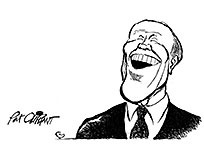
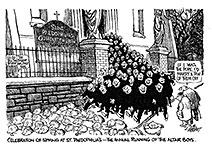
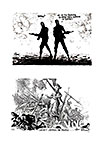
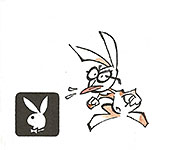
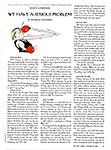
1.jpg)
2.jpg)
3.jpg)
4.jpg)
5.jpg)
6.jpg)
7.jpg)
8.jpg)
9.jpg)
10.jpg)
11.jpg)
12.jpg)
13.jpg)
14.jpg)
15.jpg)
16.jpg)
18.jpg)
19.jpg)
1.jpg)
2.jpg)
3.jpg)
4.jpg)
5.jpg)
Dennis1.jpg)
Dennis2.jpg)
Dennis3.jpg)
Dennis4.jpg)
Dennis5.jpg)
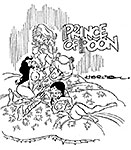
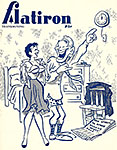
12.jpg)
